Ri lu vd er S mlor Rs iver Slumlords























































































































Lead in the tap water. Toxic mold. Cratered roofs. More than two dozen tenants have lived for years in dilapidated dwellings leased from the Eno River Association. Now, their absentee landlord wants to sell the land, and their homes, to the state. by Lena Geller, p.12 TheINDY’s 2022Midterms EndorsementsDurham | Chapel Hill October 26, 2022
THOMASI MCDONALD
THOMASI MCDONALD
 MCDONALD
LENA GELLER
MCDONALD
LENA GELLER
2 October 26, 2022 INDYweek.com
COVER Photo by Austin Dixon | Design by Jon Fuller and Nicole Pajor Moore
W E M A D E T H I S CONTENTS THE REGULARS NEWS 6 Durham's incumbent sheriff romped through the primary but he faces a formidable challenge this fall. BY
8 Scientists emphasize coal ash risks as Chapel Hill weighs redeveloping a site that sits atop a coal ash pit. BY CHAD KNUTH 10 More than a century of history burned up in the unpermitted demolition of an old log cabin in East Durham. BY THOMASI
12 More than two dozen tenants have lived for years in dilapidated dwellings leased by the Eno River Association. Now their absentee landlord wants to sell the land, and their homes, to the state. BY
15 2022 Voter Guide BY STAFF 16 Raleigh City Council endorsements. BY JANE PORTER 20 Can Democrats and Republicans find common ground solutions to deter mass shootings? BY ANNE BLYTHE 22 A Durham woman is one of the nation's 60 living supercentenarians. BY
ARTS & CULTURE 24 Traveling GRAMMY exhibition 'The Power of Women in Country Music' comes to Raleigh. BY AMANDA WICKS 26 Twenty-four years after their last album, Chapel Hill torchbearers Archers of Loaf release a new album. BY BRIAN HOWE 27 Cafe owners Amy Coughlin and Andy Pignatora hope to cultivate an inviting community for cyclists and pedestrians alike. BY GABI MENDICK Raleigh W Durham W Chapel Hill VOL. 39 NO. 43 PUBLISHER John Hurld EDITORIAL Editor in Chief Jane Porter Managing Editor Geoff West Arts & Culture Editor Sarah Edwards Staff Writers Jasmine Gallup Thomasi McDonald Lena Geller Copy Editor Iza Wojciechowska Interns Chad Knuth, Lia Salvatierra Nathan Hopkins Contributors Madeline Crone, Grant Golden, Spencer Griffith, Lucas Hubbard, Brian Howe, Lewis Kendall, Kyesha Jennings, Glenn McDonald, Nick McGregor, Gabi Mendick, Dan Ruccia, Rachel Simon, Harris Wheless CREATIVE Creative Director Nicole Pajor Moore Graphic Designer Jon Fuller Staff Photographer Brett Villena ADVERTISING Publisher John Hurld Sales Digital Director & Classifieds Mathias Marchington CIRCULATION Berry Media Group INDY Week | indyweek.com P.O. Box 1772 • Durham, N.C. 27702 Durham 320 East Chapel Hill Street, #200 Durham, N.C. 27701 | 919-286-1972 Raleigh: 16 W Martin St, Raleigh, N.C. 27601 EMAIL ADDRESSES first initial[no space]last name@indyweek.com ADVERTISING SALES advertising@indyweek.com Raleigh 919-832-8774 Durham 919-286-1972 Classifieds 919-286-6642 Contents © 2022 ZM INDY, LLC All rights reserved. Material may not be reproduced without permission.
Alice Street screens at the NCMA on Saturday, October 29. (See calendar, page 28.) PHOTO COURTESY OF NCMA
3 Backtalk 5 15 Minutes 28 Culture Calendar4 Quickbait | Drawn out Corrections: Last week in our print edition of the paper, we neglected to include our endorsement of Orange County Rep. Graig Meyer who is running for the state Senate. You'll find that endorsement this week on page 4. We also included state Rep. Vernetta Alston, who is running unopposed for her seat, in the Wake County section of our endorsements. Alston is a lawmaker from Durham. And in our Quickbait, there was an error in our reporting about how many U.S. Senate seats are up for grabs this year; 35 of 100 seats are up for re-election.
T A L K
B A C K
Two weeks ago, Jasmine Gallup wrote a piece for the web on Raleigh City Coun cil candidates’ responses to Habitat Humanity of Wake County’s questionnaire regarding affordable hous ing. Longtime Raleigh resi dent and former INDY Week columnist Bob Geary had this to say in response to the story:
Their “pro-growth strategies” are systematically pushing low-income residents out of Raleigh, while allowing develop ers and builders to serve only the affluent. (Which, of course, provides them the greatest profits.)
So yes, I do oppose their “pro-growth strategies.” I do believe the existing stock of small, affordable homes and duplexes and older apartment buildings in existing neighbor hoods (not just single-family neighborhoods) should be given some measure of protection from the scrape-off scourge cur rently occurring.
The candidates I support hold this same view, as I under stand them, though again I speak only for myself.
I support: In the biggest development projects, affordable housing units MUST be included.
As you know, state law is said by the development industry to prohibit “requiring” this. But the whole process of condi tional zoning that prevails in North Carolina ABSOLUTELY allows cities to reject upzoning proposals that do not fulfill critical community needs.
Affordable housing is such a need.
sive houses or townhouses where previously only a single house—often a modest, older house—was sited.
To be clear, I support “missing middle” policies intended to produce additional smaller, affordable homes and apartment units in neighborhoods.
That’s not what we got.
It’s ironic that the actual outcome is overshadowed by the headline case in affluent Hayes Barton. But even there, tear ing down a large old house should’ve made way for at least a few relatively affordable units in the replacement project. But since there’s no such requirement or even incentive to be inclusive in our “missing middle” scheme, the developer is going for maximum profit.
(I would add parenthetically that when some of us pointed out what was MISSING in “missing middle” we were ignored and the policies were adopted with virtually no public dis cussion or debate. The kind of vetting that occurred in CAC meetings, always despised by our mayor, didn’t happen. Not her thing, obviously.)
I was struck by this summary description of the Raleigh candidates in the piece on the Wake Habitat questions:
“Most of the city council candidates are divided into two camps—those who support upzoning to allow developers to build denser housing and those who oppose the city's progrowth strategies, arguing council members should do more to protect existing single-family neighborhoods.”
It stuck in my mind because it’s sort-of true as far as it goes but is finally inaccurate, I think, in that it leaves the impres sion—intended or not—that candidates in the first camp are pro-growth and those in the second are anti-growth.
Better to say that the first camp favors letting the market work without regulation, arguing that it will serve rich and poor alike—but knowing that it won’t—while the second camp favors using the powers of city zoning to assure that growth occurs and serves the interests of all.
I am supporting the second group of candidates, and speak ing only for myself, I am unabashedly pro-growth, and in fact believe that the policies I favor would produce more growth, not less, in the long run, and the same amount, but distribut ed differently, over the near term.
The big advantage of these policies over the current Council’s?
Equity.
The current mayor and Council majority insist there’s nothing they can do to influence the mix of incomes in a high-rise project. The truth is, there’s nothing they WANT to do except rubber-stamp developers’ plans, then insist that approving more luxury apartment projects will some how benefit lower-income people by the mysterious magic of “filtration.”
Formerly known as trickle-down.
The upshot of their “pro-growth strategies” is that the enormous profits that accrue when land is upzoned for a 20-, 30- or 40-story building ALL go to the developers and their bankers and investment funds. Hundreds of millions of dol lars in profits, and ultimately billions of dollars, that could have been more widely shared within the city are instead hoarded by a few, including many investors who live some where else.
This could be why, as fast as Raleigh is growing, our local tax rates are not falling, but instead are on the rise.
(Wait, do I sound like Bernie Sanders?)
The same policy of inclusion that I advocate for the biggest projects should also have been applied to the so-called “miss ing middle” text changes.
MM was sold as a way of allowing more affordable homes in every neighborhood. But in practice, because no guardrails were put in the texts (or exist anywhere else in the UDO), “missing middle” is a free pass to build multiple large, expen
I support density—high-rise, inclusive density—downtown and along major corridors served by bus transit today or with clear plans for future bus transit.
Almost every old shopping center on every highway in Raleigh can be turned into a future high-rise, mixed-use, inclusive and transit-served development.
Current Council policies, however, spread high-rise density thinly across Raleigh instead of concentrating it on current or future transit corridors. I call this Sprawl 2.0, because it not only does NOT encourage transit ridership, it undermines any hopes of converting Raleigh from car dependence to a transit-supported future.
This is why I said at the outset that our smarter-growth policies would allow for MORE future growth than their lib ertarian “let the market govern” policies.
Traffic congestion is still manageable in Raleigh, but not for long. What happens when the two or three cars that go with every Sprawl 1.0 house are supplanted by 200 additional cars attached to a 100-unit apartment building (to pull figures out of the air) permitted in a place where no transit is planned?
Raleigh’s current leadership is pretending to be pro-tran sit, but their policies—those “pro-growth policies” to which I object—are adding geometrically to our car dependence.
Where high-rise projects are served by transit, equity inter ests are also served.
Luxury high-rise apartments attached to giant parking decks for hundreds of cars? Not so much.
INDYweek.com October 26, 2022 3
WANT TO SEE YOUR NAME IN BOLD? indyweek.com backtalk@indyweek.com @INDYWeekNC @indyweek
QUICKBAIT
Frightfully Popular Costumes
 BY NATE HOPKINS backtalk@indyweek.com
BY NATE HOPKINS backtalk@indyweek.com
The only day of the year when it's socially acceptable to bring a lightsaber to work is coming up.
With Halloween right around the corner, many have already picked out a costume to wear—and if you decided to dress up as Eleven from Stranger Things or as Marvel’s Spider-Man, you’re not the only one.
Google analyzed web searches to determine the most popular Halloween costumes this year across the country and offered its findings on the website “Frightgeist.” Here are the year’s top picks for spooky get-ups.
Races
Bunny
Things



Harley Quinn
NC Senate District 23 Graig R. Meyer
Graig Meyer has served in the state house since 2013 and first ran as an educator on a pro-public-schools platform. Meyer has many accomplishments to show for his time in Raleigh, including leading on legislation that would legalize cannabis, create universal paid family leave, and provide voter registration services and other assistance to voters should a voter ID requirement become law.
That’s not to mention the work Meyer has done to pressure the legislature to fully fund K-12 education and strengthen the Democratic caucus by chairing various legislative committees.
Meyer’s opponent, Landon Woods, owns a solar energy business, according to his website. If you think that’d somehow make him know better, you would be wrong. Woods’s campaign website is organized around the principles of “freedom,” “taxes,” and “safety”; this translates into public education being wrong for “pushing a left-leaning agenda,” a ban on abortion “with some exceptions,” stopping the (nonexistent) teaching of critical race theory and “gender fluid pronouns,” and not accepting the result of the 2020 election, per responses to a News & Observer candidate questionnaire. Get this guy outta here.


4 October 26, 2022 INDYweek.com
4 1 2 3 5 Nationally North Carolina Stranger Things Witch Spider-Man Dinosaur Fairy Triangle Area Witch Spider-Man Dinosaur Fairy Harley Quinn DRAWN OUT
Spider-Man
Witch Stranger
orange countyorange county Local
INDY endorsements Source: Google Trends/Frightgeist
MINUTES
Jack Sochet
Actor in the horror film Smile
BY LENA GELLER lgeller@indyweek.com
Without giving too much away, tell us about your Smile character.
I play Carl Rankin, who is a frequent visitor to a psychiatric facility. Carl keeps coming in and out, trying to figure out his way in the world. His thought process is a little bit off, and it’s very sad for him. On set, people would call me “poor Carl.”

How did you land the role?
The casting director gave me two sets of sides, which is a few different papers you have to memorize and perform on tape. My wife is a psychiatrist at Duke Hospital, so I borrowed some of her scrubs and we worked on it together, then we sent the tape off. We have a family debate over who actually got the role.
Were there any moments that felt scary while you were filming them?
It is not, like, overt fear. But when you leave [the set], you have to kind of let yourself come down. I would drive home and talk to friends, and I really love chocolate milk, so I’d always have a chocolate milk when I got home, as something comforting. I was always really afraid of horror films. I don’t think I’ve gone to a theater to see one in a while. But after working on [Smile], you see the creativity in it. I think there’s a freedom to it. [Horror films] can talk
about things that you aren’t always allowed to tell in other mediums. So this movie has kind of opened up that genre to me.
Do you think the movie has any “real world” application or meaning?
I really like how the film deals with our own traumas and how we handle and process them. It plays with the idea of getting someone to believe that something is going on, and the whole concept of having to convince people of our truth.
Have you gotten recognized? If I didn’t know you lived in Durham and I saw you walking around, I would be a bit spooked.
Not too much, because luckily I don’t normally look like Carl. But I actually went to get a poster at a print shop recently, and the guy was like, “You look familiar,” and I was like, “You’re going to die.” He freaked out. We took pictures. So he maybe didn’t actually recognize the face, but he recognized me once I said the line.
Do you have Halloween plans?
My sisters think that I should dress up as Carl and walk around. But I don’t want to give too much away.
Find out what you’re doing this weekend.
Weekly music, food & culture calendars are available online and in print every Wednesday

INDYweek.com October 26, 2022 5
Durham 15
CONTRIBUTED PHOTO
A Formidable Challenge
Durham’s incumbent sheriff Clarence Birkhead romped through the primaries, but beating Maria Jocys won’t be so easy.
BY THOMASI MCDONALD tmcdonald@indyweek.com
As he’s campaigning, Clarence Birk head, Durham County’s first Black American sheriff, touts his decision to ban no-knock warrants, the kind that killed Bre onna Taylor two years ago and Amir Locke in February.
But Birkhead’s challenger, retired FBI agent Maria Jocys, in her effort to deny the pioneering sheriff a second term, says the incumbent should not list the banning of no-knock warrants as one of his first-term accomplishments because he never imple mented the policy.
“I’ve spoken to a number of people in the sheriff’s office who say there has never been a no-knock ban,” Jocys told the INDY last week.
And, she notes in an INDY Week candi date questionnaire, Birkhead “cannot point to a policy or even press release which announced an official no-knock ban.”
The INDY this week asked the sheriff and the sheriff’s spokesman, David Bowser, for a copy of a written policy or general orders issued by the incumbent banning no-knock warrants. The sheriff’s office did not submit a policy in writing.
“North Carolina law banned no-knock warrants years ago,” Birkhead said in a text message to the INDY. “And the policy here at the Durham County Sheriff’s Office is that we don’t use no-knock warrants.”
State statutes don’t explicityly ban no-knock warrants, though they require law enforcement officers to announce them selves. They give officers some discretion to use force. An officer “may use force to enter the premises or vehicle” if the offi cer “reasonably believes that admittance is being denied or unreasonably delayed, or if he is authorized ... to enter without giving notice of his authority and purpose.”
Jay Utley, who retired on June 30 with the rank of sergeant from the Durham County Sheriff’s Office, says Birkhead never imple mented a ban on no-knock warrants; not by policy, email, or via a directive through an electronic system informing officers of a change in policies and procedures.
“Your guess is as good as mine,” Utley answered when asked why Birkhead would tout a policy that doesn’t exist.
“Something political would be my guess.”
“This is something that’s important to Durham values,” says Jocys, who adds that the Buncombe County Sheriff’s Office, the Charlotte-Mecklenburg Police Department, along with the FBI and U.S. Department of Justice all prohibit no-knock warrants. She later adds that Birkhead’s missing-in-action ban “speaks to his character and integrity” and “is not an accomplishment.”
Jocys says that rather than enacting reforms that make communities safer and
rebuild community trust, Birkhead’s tenure as the county’s top law enforcement officer has been “a big old bag full of empty prom ises, nothings, and falsehoods.”
“What reforms?” she asks.
Jocys says she wants to position the sher iff’s office “as a true champion of reform” that leads the state “in local reform initia tives that are actually implemented.”
The incumbent garnered endorsements from the city’s most influential political action committees—the Durham Commit tee on the Affairs of Black People, the Peo ple’s Alliance, and the Friends of Durham— along with endorsements from the Progres sive Caucus of the NC Democratic Party and the INDY
Birkhead—one of seven Black men elect ed in 2019 to serve as sheriff in the state’s largest counties—lists his first-term accom plishments on his website. Highlights include serving on Gov. Roy Cooper’s Task Force for Racial Equity in Criminal Justice, rejecting ICE detainers that “target mar ginalized communities,” banning “no-knock warrants,” and implementing “Eight Can’t Wait” polices to reduce police violence fol lowing George Floyd’s murder in 2020.
Birkhead easily beat challenger Paul Mar tin in March’s Democratic Party primary and anticipated running unopposed in the midterm election.
In May, Jocys announced that the Durham County Board of Elections (BOE) validated 9,599 signatures from the county’s regis tered voters in support of her campaign and certified her as a candidate on the mid term ballot.
She’s a formidable candidate. Jocys’s 32-year career in law enforcement includes 24 years with the FBI, where she was a member of a global counterterrorism task force, and she later became the first woman to lead the agency’s Raleigh office. She was also a member of a federal gang-and-vio lent-crimes task force in Durham for five years before retiring late last year.
J ocys seemed to appear out of nowhere to challenge Birkhead, and there’s the perception that she isn’t really a part of the Durham community or that she’s play ing to the mind-sets of older, whiter, con servative voters who have an outsize fear of rising crime.
Although she’s not likely to be seen vol unteering at the Scrap Exchange, the retired FBI agent is a towering presence in the Bull City’s law enforcement community. Days after her retirement, Durham police chief Patrice Andrews sent her a letter that rec ognized her “dedication, commitment and perseverance in the pursuit of justice for all the citizens” of Durham.
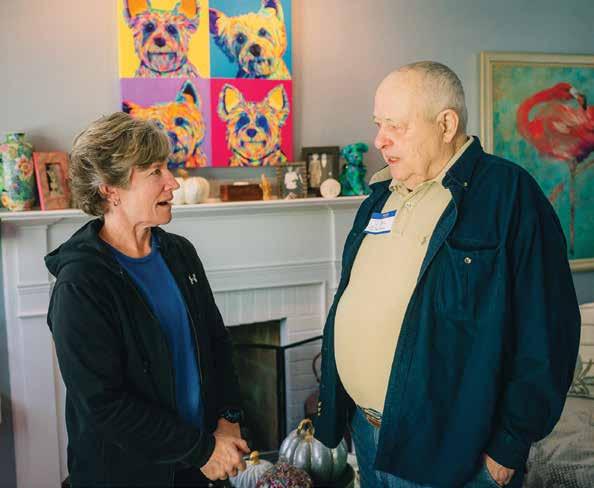
6 October 26, 2022 INDYweek.com N E W S Durham
Maria Jocys talks with a voter at a recent meet-and-greet in Durham
PHOTO BY BRETT VILLENA
“You have been a teacher, mentor and exemplary model for all our officers to learn from,” Andrews wrote in the January 6 letter.
The sheriff’s race became contentious when Jocys came out swinging with point ed criticism about Birkhead’s response to the record levels of gun violence across the city and county.
She pointed to a record number of shoot ings in 2020 and a record number of homi cides in 2021.
Jocys accused Birkhead of publicly stat ing that his office is not responsible for violence that takes place inside the city at a virtual event, the Leesville Road Coalition candidate forum, on March 22.
The INDY reviewed the forum, in which Birkhead asserts that he is “not responsible for the violent crime that occurs inside the Durham city.”
“This is my county,” he says. “This is my city. I have citywide jurisdiction, but I do not carry the stats.”
“A city resident is a county resident, a city taxpayer is a county taxpayer,” Jocys later told the INDY. “It’s an admission that he’s not focused on the city’s gun violence. The current sheriff, for all of his tough talk, is just talk and not leadership.”
Jocys easily surpassed the 9,248 signa tures needed before a May 17 deadline to appear on the midterm ballot.
One month later in June, Birkhead filed a complaint with the Durham County BOE that challenged Jocys’s right to be placed on the midterm election ballot after the state BOE announced that the challenger’s campaign was under investigation to deter mine why the names of thousands of regis tered voters that appeared on her petition to get on the ballot are invalid.
In a request to keep Jocys’s name off of next month’s ballot, Birkhead also ques tioned the challenger’s political affiliation.
It took BOE members less than 10 min utes to dismiss Birkhead’s challenge after determining the incumbent failed to pres ent any evidence that showed the more than 9,000 signatures that appeared on Jocys’s petition should not have been certi fied by local elections officials.
T he INDY endorsed Birkhead’s run for a second term in the primary and for the midterms. Last week he shared a list of accomplishments that include two gun buy back events that resulted in more than 400 weapons turned in and that he has peti tioned the General Assembly “to act on 10 bills regarding gun safety.”
“One in particular is the stalled ‘red flag law’ that, if passed, would have a signifi cant effect on more commonplace types of gun violence, domestic violence and sui cide, which accounts for the majority of U.S. gun deaths,” Birkhead stated in an email to the INDY
Birkhead adds that his office is work ing to identify and hold violent offenders accountable and points to a detention cen ter that never closed during the pandemic and a mental health staff that counsels and provides treatment for people in need of services while in custody, along with edu cational services, life skills, job counseling, and reentry back into the community.
Still, the INDY’s endorsement of Birk head is accompanied by a growing bundle of caveats owing to misfires during his first term.
The INDY in April reported that the sher iff’s office has a mutual aid agreement with Alamance County that enables deputies from that county to patrol Bull City streets. Alamance County is one of the most con servative counties in the state and its depu ties are led by a sheriff who is known for his anti-immigration trash talk and pro–Con federate monument values.
There are also questions of transparency following the mysterious death of J’Mau ri Bumpass, the 18-year-old who died in late 2019 during a sheriff’s deputies’ traffic stop. The deputies first said Bumpass died as a result of crashing his car into a power pole but later said he died of a self-inflicted gunshot wound.
The teen’s family filed a federal civil rights lawsuit that accuses the two deputies who pulled over Bumpass of killing him and con spiring to cover it up. Birkhead was among those named in the complaint for his role in the alleged conspiracy.
Allyn Sharp, the Durham attorney repre senting the Bumpass family, told the INDY this week that the case is still pending.
In August, the INDY received an anon ymous letter from a self-described coun ty detention center employee who claimed that Birkhead last year issued a new man datory requirement that orders all deputies to work overtime at least two days a month at the jail in response to staffing shortages at the facility.
The whistleblower also claimed that offi cers uncertified in basic detention training were “actually manning entire pods within the jail, by themselves.”
In defense of the incumbent, Durham’s increased gun violence and staffing short
ages among law enforcement are mirrored nationally since the onset of the COVID-19 pandemic and lowered morale among law officers’ ranks after the police murder of George Floyd.
Birkhead told the INDY that Durham has to do a better job compensating sheriff’s employees.
“On average, one Durham County Sher iff’s Office employee is lost per month to other Triangle-based law enforcement agen cies paying up to 20 percent more,” he says.
R ed flags went up with the Jocys cam paign after the INDY reported that she hired Mack Douglas, a right-wing firm that helped her gather the petition signatures she needed to appear on the ballot. The sig nature gathering process was investigated by state elections officials.
Jocys says when she looked for a pro fessional signature-gathering firm, she did not find any indication that the company works chiefly for Republican and conser vative candidates, even though the com pany’s now-defunct website notes that it is “Republican/Conservative” in a banner underneath its name.
As for the botched signature-gathering process to appear on the ballot, Jocys says that she is the only Durham candidate in recent years to get on an electoral ballot after petitioning for signatures.
“Getting the required number of signa tures is almost insurmountable without help,” she says.
Jocys says she participated in candidate forums at the Holton recreation center, NC Central University, and the Parkwood com munity’s mosque and knocked on doors in some of the city’s most violence-riddled communities, along East Main Street and near Dearborn Drive.
“The gun violence,” she says about her conversations with residents in those neighborhoods. “They want something done. What people are saying, their con cern is ‘Does anyone care?’”
Both candidates say reducing gun vio lence and helping to create safer commu nities are top priorities, but they also differ on several key issues.
Birkhead, for instance, opposes the cre ation of an independent civilian review board to review use-of-force complaints, telling the INDY that state law prohibits him from “delegating any constitutional and statutory duties and authorities.”
Jocys, on the other hand, told the INDY that she “absolutely” supports the creation
of a civilian review board.
“My Six Point Plan for Reform includes creating a Civilian Review Board that includes members from diverse groups who recommend reforms, training, policies, and procedures to help transform the sheriff’s office into a state leader on police reform,” Jocys states in the INDY’s candidate ques tionnaire. “The board,” she adds, “will also review citizen complaints, use-of-force, and other incidents to provide guidance on improving service.”
Meanwhile, Birkhead points to a com munity advisory board (CAB) he created to “solicit input from the community, a first of its kind in North Carolina.”
“In CAB Meetings, I discuss policies, pro grams and answer community questions about specific incidents, events and crimes to the extent permitted by law,” he explains.
Jocys is not impressed, saying the sheriff promised in 2018 to create a citizen review board “to bring the power of accountabili ty to the people,” but “a true review board never materialized.”
The sheriff’s CAB, Jocys adds, “can only offer advice and cannot hold the sheriff accountable for anything.”
Birkhead, who has lived in Durham for more than 30 years, says his first term gave him a “firsthand perspective on the ongoing challenges facing our local community,” and that being the county’s first Black Ameri can sheriff affords him “a unique viewpoint” while allowing him to witness the deterio rating fabric of Black and Brown communi ties as a result of guns and drugs.
Far from shying away from criticism that he invited Alamance deputies to patrol Durham neighborhoods, Birkhead maintains that he developed a “region al strike team of highly trained sheriff’s deputies cooperating across four coun ties … to remove violent offenders from our streets.”
Meanwhile, Jocys wonders why the incum bent does not strengthen his partnership with the city’s police department to help reduce gun violence in the city limits.
And she asks: “What program can [Birk head] cite that he did as an intervention to prevent more people entering into the crim inal justice system, or to the grave?”
“Reducing crime means getting into inter vention services,” she says. “I investigated international terrorists for 15 years, and prevented plots here in the United States and overseas that were plotted and planned in foreign countries. If we can do that, we can prevent violent crime in Durham.” W
INDYweek.com October 26, 2022 7
Coal Ash Conundrum
Residents worry as Chapel Hill makes plans to build atop a 60,000-ton coal ash deposit.
BY CHAD KNUTH backtalk@indyweek.com
Managing coal ash in North Carolina has long been a sordid issue. Last month in response to the Town of Chapel Hill’s proposal to build on top of an existing 60,000-ton coal ash deposit without removing the coal ash, a group of residents known as Safe Housing for Chap el Hill hosted three of the nation’s top coal ash scientists in a public forum in an effort to educate citizens on the dangers attributed to coal ash.
“Coal ash is the new asbestos,” said Edward Marshall, a professor in Duke’s school of engineering who spear headed the forum.
The property at the center of the debate runs along the Bolin Creek Parkway at 828 Martin Luther King Jr. Boulevard, one mile north of the heavily trafficked Frank lin Street. It has been the sole home to the Chapel Hill Police Department since the 1980s, but it is also the site of a coal ash infill that dates from the 1960s and ’70s.
When plans for reconstruction of the current police station were initially submitted in 2013, the Town of Chapel Hill discovered the buried coal ash deposit at the site, and officials have since been looking to remediate the property.

Current plans that the town has released outline the construction of a roughly 80,000-square-foot new munic ipal services center, which is set to include a reconstructed police station, alongside the addition of private develop ment and a total of 225 to 275 multifamily residential rental units, all of which would be built directly over the existing 60,000-ton coal ash deposit.
“The town [of Chapel Hill] has failed to make a com pelling, science-based case for building on top of 60,000 tons of coal ash,” Marshall said at the meeting. “All we want the town to do is remove the coal ash before build
ing anything. It is the town council and mayor’s moral and public health responsibility to keep our citizens safe—the proposed plan does not do that.”
Chapel Hill mayor Pam Hemminger, however, says the town understands the dangers attributed to coal ash and further assures that current plans to not remove the coal ash have been well researched.
”We can all agree that there are concerns surrounding the coal ash,” she says. “We’ve explored digging [the coal ash] out, but that was going to cause more environmen tal concerns in many ways, causing fly ash and just all of the hazards associated in digging it up and carting it out with trucks. It would ultimately endanger the community more [to remove it].”
Hemminger has since stated that, due to costs, plans for any residential units to be built on the site have been pushed into later project phases, while plans for the municipal center and reconstructed police station remain under way.
For Marshall and others attending the forum, the removal of residential units from development plans is not nearly enough. They asked why the town seemed to be dodging the glaring issue at hand.
Hemminger declined to attend last month’s forum, as did all but one member of the town council, Adam Sear ing. Searing was the only town council member to vote against the proposed redevelopment project.
“It’s wonderful that the community is asking the ques tions they are,” says Hemminger, “but we’ve employed topnotch scientists and we’ve met with the [NC Department of Environmental Quality], and this group of citizens [who
attended the forum] had also met with the DEQ, and they were told the same thing we were: that capping it and controlling it where it was is the best way forward.”
Officials from NC DEQ also declined to attend last month’s forum.
“This has been going on for a long time now,” Hem minger continues. “[The town has] been very forthcom ing and up-front about everything. I learned about this when I came in as mayor seven years ago, and we’ve been posting our progress, and continually testing, and doing constant monitoring of the groundwater and the creek. We’re happy to say the creek has shown no sign of ever having coal ash in it.”
Earlier last month, the town issued a memo discussing the proposed project’s current status.
“Over the summer, we have continued to work with the NC DEQ through the EPA’s Brownfields Program,” the memo states. “We have, also, continued to work with Hart & Hickman, our environmental consultants, who are in the process of conducting on-going monitoring and additional testing of on the site at NC DEQ’s request as a standard procedure for the Brownfields Program.”
The EPA’s Brownfields Program provides grants and technical assistance to communities, states, tribes, and others to assess, safely clean up, and sustainably reuse contaminated properties. It is estimated that there are more than 450,000 Brownfields properties in the Unit ed States.
According to NC DEQ, as documented during a public meeting Q&A back in May, the Brownfields Program “is still reviewing assessment data collected at this site and
8 October 26, 2022 INDYweek.com N E W S Chapel Hill
Chapel Hill Police Department at 828 Martin Luther King Jr. Blvd. PHOTO BY BRETT VILLENA
some additional assessment is anticipated to occur …. The primary identified contam inants at the Chapel Hill Police Property are elevated metals from the coal ash.”
The presence of the elevated metals was a focal point at last month’s forum. The metals include antimony, arsenic, cad mium, chromium, lead, mercury, radium, radon, thallium, thorium, and uranium, all of which are known to cause serious health effects due to exposure.
Scientists at the forum took turns exchanging collected research on the effects of coal ash exposure with grave concern.
Avner Vengosh, a professor of envi ronmental quality at Duke, reported that the composition of soil samples taken at 828 MLK Jr. Boulevard revealed a total of 19 toxic metals, including levels of arsenic, lead, and radium that were three to four times what the EPA allows.
Health risks from exposure to met als found in coal ash include damage to the liver, kidneys, and heart, as well as ner vous system damage and even lung, pros tate, and urinary tract cancers, to name only a few.
“Overall, studies show higher all-cause mortality; rates of premature deaths and infant mortality; higher risk of cardiovas cular and chronic respiratory diseases; lung cancer; and higher prevalence of low birth weight in newborns reported in association with air pollutants related to coal-burn ing power plants,” wrote Julia Kravchenko, an associate professor of surgery at Duke School of Medicine, in a research paper published in 2018.
Kravchenko’s research shows that, unfortunately, studies with direct measure ments of exposure and health status in the communities adjacent to landfills or coal ash impoundments in the United States are currently not available.
In addition, no studies with direct mea surements of individual or group/commu nity exposures that can provide a scientific rationale for policy changes in the United States are currently available.
Vengosh and Kravchenko both attend ed the forum, along with Susan Wind, a former resident of Mooresville, who joined in an effort to share her daughter’s story.
Wind’s daughter, Taylor, who now suffers from thyroid cancer, was one of at least 25 children and teens in the Lake Norman area who have been suspected to have contracted cancers related to the improp er disposal of coal ash in their community.
The state’s Central Cancer Registry sta tistics showed that for the past 26 years Iredell County has reported higher inci dences of thyroid cancer than the state average, in some cases three times greater. In May 2018, state and county health offi cials designated two zip codes near Lake Norman as suspected cancer clusters, one of them being 28117, where the Wind family had resided.
Lake Norman High School, where Wind’s daughter was in attendance at the time of her diagno sis, was discovered to have been built alongside a 42,000ton coal ash depos it, a site not dissimilar to that at 828 MLK Jr. Boulevard.
According to Wind, a number of the chil dren and teens in the Lake Norman area who had contracted cancers similar to her daughter’s have since passed away from complications.
Pamela Schultz, former chair of the Chapel Hill Stormwater Advisory Board, spoke after Wind.
“Our bodies are not designed to be exposed to these chemicals, but the con versation is that there are no short-term effects due to exposure to coal ash,” she said. “We need more medical data. The risks are greater than what we have believed.”
As the town starts its long journey on the road of remediation, Hemminger ensures that the Town of Chapel Hill has been committed to redeveloping the site safely from the start.
“We’re all learning how to live with it,” Hemminger says. “We’re learning as much as we possibly can.”
N O V E M B E R 8 , 2 0 2 2 E L E C T I O N
At a meeting duly called and held on the 18th day of October 2022, at 2445 S. Alston Avenue in Durham, North Carolina, the Durham County Board of Elections passed the following resolution:
WHEREAS the county board of elections is authorized upon adoption of a resolution to begin counting all absentee ballots between the hours of 2:00 p.m. and 5:00 p.m. on Election Day;
WHEREAS such resolution also may provide for an additional meeting following the day of the election and prior to the day of canvass to count absentee ballots received pursuant to N.C. Gen. Stat. §163-231(b)(1) or (2);
WHEREAS the times for these meetings will be at 2:00 p.m. on Tuesday, November 8th and Thursday, November 17th for the purpose of counting absentee ballots;
WHEREAS the location of these meetings shall be held at the BOE warehouse, located at 2445 S. Alston Avenue, Durham, NC 27713;
WHEREAS the Board shall not announce the results of the count before 7:30 p.m. on Election Day;
WHEREAS these meetings are open to all who may want to attend; and,
WHEREAS the adoption of this resolution is in compliance with N.C. Gen. Stat. §§ 163-234 (2) and (11) and will be published in a newspaper of general circulation in the county within the statutory time frame.
NOW, THEREFORE, BE IT RESOLVED that the Durham County Board of Elections hereby unanimously approves the time for Counting of Absentee Ballots as set forth above.
This the 18th day of October 2022.
Dawn Y. Baxton, Chairwoman Durham County Board of Elections
INDYweek.com October 26, 2022 9
R E S O L U T I O N T O A D O P T T I M E F O R C O U N T I N G O F A B S E N T E E B A L L O T S
W
“We need more medical data. The risks are greater than what we have believed.”
Memories Aflame
City fire officials denied a company’s permit to burn a historic dwelling. The company burned it anyway.
BY THOMASI MCDONALD tmcdonald@indyweek.com
Willie Lee Thompson was swept up in a flood of memories after someone sent him a YouTube video showing a log cabin that had been hidden for more than 70 years under the siding of an old home in East Durham last month.

Thompson, an 84-year-old resident of Long Branch, New Jersey, figures he was about four years old around 1941 or 1942 when his parents, Frank and Maude Thompson, bought a three-acre parcel of land in Durham’s Merrick-Moore communi ty that was divided into three lots.
His parents sold two of the lots.
“The log cabin sat in the middle,” says Thompson, who thinks it was built in the late 1800s. “It was a feed barn at first, and initially located about 200 yards west of its present location. It was old, but it was very well made.”
Late last month, workers with a local demolition company removed the siding of an old home in the 800 block of Cen ter Street and discovered the log cabin underneath.
The discovery generated a lot of excite ment, especially among the city’s preserva tion officials after a member of the demo lition crew posted a video of the old struc ture on YouTube.
Inexplicably, the demolition crew applied for a permit to burn the log cabin away after it was uncovered.
City fire officials denied the burn permit, they confirmed to the INDY Undeterred, the demolition crew burned the log cabin anyway.
“This find was called in,” states the nar rator of the video, which was posted on September 22. “It is not part of a historic district.”
The next day, the workers dismantled
the log cabin and burned away the centu ries-old round logs, dried mortar, and bits of wood used to fill in gaps in the struc ture. Then, they burned the rest.
Last week, city fire officials informed Cameron Huffman, the owner of Raleigh Tree and Demolition, that the company was working without a permit.
The September 23 unpermitted burning of the log cabin marked one year since officials with the NC Department of Insur ance charged Huffman with a felony count of obtaining property by false pretense.
Special agents with the state depart ment’s criminal investigations division accused Huffman of obtaining $20,000 from a customer after advertising his com pany, Oak City Tree Service, had full liabil ity insurance.
State investigators said Huffman had “presented false and misleading infor mation” to a customer in Raleigh, when he claimed that his company was fully insured. But then the customer “sustained damage when the landscaping [surround ing her home] was disturbed from the tree and brush removal, and water ran into her house.”
When the customer attempted to file an insurance claim with Huffman’s insurance company, they learned “the tree service was not insured as advertised.”
During the month that Huffman was arrested, an orange banner at his online site indicated Oak City Tree Service was “Permanently Closed.”
Huffman started Raleigh Tree and Dem olition Service the same month, accord ing to records filed with the secretary of state’s office.
Huffman was not immediately available for comment.
More than 500 people viewed the video of the log cabin discovery titled “Old Log Cabin Was Hidden Under Siding And Additions In Durham, NC!”
The video was posted on social media by Carlos Rocha Services. Company officials could not be reached for comment.
Thompson, the log cabin’s former resi dent, remembers the day his parents sum moned a man with a tractor to drag the then at least half-century-old barn to its present location.
“He came on the backroads, on a trac tor with metal wheels that had spikes,” Thompson told the INDY
Thompson says he was living with his parents and, at that time, five siblings on Ray Road, about three miles away from the log cabin on Center Street.
The old dwelling was so well made, Thompson says, his mother decided to convert it into their family home.
“We lived in a white house,” Thompson says. “My mother would walk down the highway everyday to work on that barn.”
Thompson says his father, who worked as a mechanic with the old Durham Dairy plant, got ahold of some cement. He remembers walking to a nearby creek to fetch buckets of water that his mother would use to mix with the cement and dirt to create a mixture that she used to daub
the cracks between the logs to fortify the structure. World War II was raging, and Thompson says it took his mother several years to finish the place in 1944.
“My father worked with the city to make ends meet and put food on the table,” Thompson says. “My mom worked every day, too. She got somebody in the neigh borhood to help build the chimney. There wasn’t any money exchanged then. Those were some poor times. People were dirt poor.”
Thompson’s neighbors also helped to build around the log cabin, eventually add ing a kitchen and three bedrooms. Thomp son’s parents had two more daughters, and by the time they reached courting age, his parents had added a front room.
It was the first house on Center Street and did not have electricity for years, or indoor plumbing. An outhouse sat about 75 yards from the drylongso home. By the 1950s, the family had dug a well on the property and later installed an electrical pump.
Thompson recalls sleeping in the first bedroom in a bed with his brother Alex. Two younger brothers shared another bed in the home.
“The place didn’t have insulation,” Thompson says. “You ever heard that old song, ‘Sleeping at the Foot of the Bed’?
10 October 26, 2022 INDYweek.com N E W S Durham
A century-old log cabin was demolished in an unpermitted burn this month.
PHOTO STILL FROM YOUTUBE
Our feet were in each other’s faces. Our mother bought surplus army blankets, and we would bury ourselves in them.”
Thompson says his father repaired Durham Dairy’s delivery trucks that trav eled all over the state. The demolition crew last month also removed from the proper ty a truck discarded by the company where his father had worked.
“It was on blocks,” Thompson says of the truck. “My daddy took a drop cord that ran from the house and used the truck as a freezer locker for meat.”
Thompson says his mother was a neigh borhood champion who petitioned for the construction of what was then Mer rick-Moore High School, served as presi dent of its PTA, and held fundraisers for school amenities, including band uniforms and curtains for the auditorium, yet still found time to petition the city for the first phone lines in the community and help reg ister Black voters.
Meanwhile, Thompson as a boy explored the nearby creek where the waters streamed across deposits of soapstone. He thinks the area may be evidence of Indigenous people who first lived in the area, after he collected arrowheads that he kept in his bedroom.
Thompson moved from the home to New Jersey in 1960. His parents lived in the home for decades after their children all moved away. His father, Frank, died in 1994. He was 83. His mother, Maude, died about three years later in 1997. She was 88.
Chris Laws, president of Preservation Durham, says he was among the city res idents who were “surprised and excited to hear about the log cabin” discovered in the community named to honor two of the founders of the NC Mutual Insurance Company, John Merrick and A.M. Moore, in 1898. NC Mutual will cease operations at the end of this month.
“I was deeply saddened to find out that it had been burned to the ground,” Laws wrote in an email to the INDY. “As a his toric preservationist, I lament any historic structure being torn down, but this feels like such a heavy loss. We would have loved to have had an opportunity to study it and learn more about its history before it was destroyed. Finding a log cabin like this is so rare, it is really a shame that it was dis carded so quickly.”
In a phone call to the INDY, Laws notes that preservationists in the past have moved similar structures to different loca tions to save them.
Instead, he says, this log cabin’s discov

ery and burning “literally happened within the scope of a day.”
“It’s so sad,” he adds. “It would not have been difficult to move [the cabin] and carry it away. It’s just one of those things where the law only goes so far to protect unused buildings.”
Laws wonders if the building dated back to the 19th century, which would make its loss all the more lamentable.
“We don’t know its story,” he says. “I wish they could have brought [Preserva tion Durham] into the conversation. But capitalism doesn’t wait. A lot of out-ofstate buyers are buying properties [in Durham], sites unseen.”
Bonita Green, a Merrick-Moore commu nity resident and president of the non profit Merrick-Moore Community Develop ment Corporation, was among the dozen or so Youtube video viewers who posted comments.
“I live down the street from this home,” wrote Green, who later told the INDY her great-grandparents briefly rented the log cabin when the Thompsons lived on a farm in Creedmoor.
When the INDY arrived at the log cabin location last week, the burned debris and other siding materials had been cleared away. The structure formerly sat in a rough ly graded open space where a stand of trees ringed the property like a horseshoe.
There were several newly constructed homes across the street from the log cab in’s former site.
Green says the demolition crew dis mantled the log cabin and filled up two large bins with wood and other materi als used to build the structure. She says a third bin appeared the following day, but they burned the remaining materials. Green says neighbors grabbed some of the logs and are using them to help define the boundaries of a planned communi ty garden named for her father, Samuel Green Sr.
Community members asked the dem olition crew to take the two bins of logs to the planned community garden site on Cheek Road.
“We told them it was closer than the landfill and they wouldn’t have to pay after dropping them off,” Green says.
Thompson says he wishes someone had “jacked up that barn and transported it to a historical site,” as the man with the tractor did for his family decades before.
“You won’t find these places anymore,” he says. “They knock them down and burn them. This was a gift.” W
Love the indy? Support the businesses that support us...

Shop local!
INDYweek.com October 26, 2022 11
River Slumlords
Lead in the tap water. Toxic mold. Cratered roofs. More than two dozen tenants have lived for years in dilapidated dwellings leased from the Eno River Association. Now, their absentee landlord wants to sell the land, and their homes, to the state.
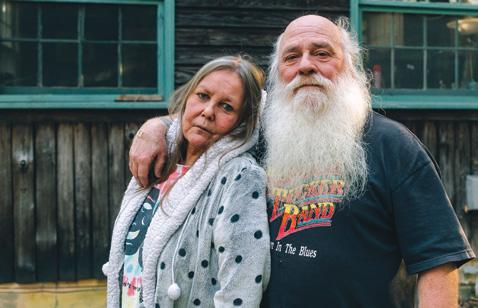 BY LENA GELLER lgeller@indyweek.com
BY LENA GELLER lgeller@indyweek.com
W hen Jerry Ellis started renting his current resi dence—a dilapidated cabin on the banks of the Eno River, built in 1905 as a day camp for children with tuber culosis—he was sure that he would live there until he died.
It was 2015, and the cabin, one of seven homes owned by the Eno River Association (ERA) on Open Air Camp Road in Durham, appeared to be at no risk of being sold; Ellis’s neighbors, most of whom had been renting their ERA-owned homes for years prior, had been told by property manage ment company V.S. Rich Property Services that they would never have to worry about displacement, and many intended to eventually initiate rent-to-own agreements.
Ellis quickly learned that the cabin’s stability—and afford ability, at $775 a month—came with a catch: almost every time he contacted the property manager, Vicky Rich, with requests for repairs, she threatened to raise his rent, he says. (Rich, who is also the president of the management com pany, said she was not available to respond to the INDY’s request for comment.) With a fixed income of $800 a month, Ellis couldn’t risk a rent increase, but he also couldn’t live safely in the decaying cabin.
So, operating under the assumption that he would live there for the rest of his life, Ellis, a trained woodwork er, spent the subsequent seven years taking matters into his own hands.
When the pillars supporting the cabin’s second-floor deck started to crumble, Ellis went into his backyard, cut down a few trees, and jacked up the deck with segmented tree trunks. When he noticed that his walls were covered in black mold, he bought a gallon of bleach and scrubbed them sterile. When a water test showed that his pipes were leaching lead, he started purchasing bottled water to drink and resigned himself to bathing and washing his clothes in contaminated water. When a tree fell on the roof, he hoisted it off himself.
He patched leaks and sealed foundation gaps. He built and installed doors, kitchen cabinets, and a closet. And he made the place his own: All of the rooms—even the ones he doesn’t go into anymore because their ceilings are
falling in—are decorated with posters and photographs. One of his DIY tree trunk pillars has a knotty outgrowth that he’s named Fred.
The cabin, in its current state, is still on the verge of unlivable. The water is nonpotable. There are leaks that Ellis, who is now 65, hasn’t been able to fix, so the black mold persists. The lead-contaminated water and the toxic mold have had a dire impact on his health. When it rains, water runs through his living room.
But he loves living there. The cabin comes with senti mental value—a Durham native, Ellis attended parties at the cabin during his high school years, when it functioned as the headquarters for a local motorcycle club—and stun ning scenery: every morning, Ellis greets the squirrels and deer in his front yard, and every night, he sits on the deck to watch the moonlight bounce off the river.
And he’s felt OK about fixing the place up. After all, there’s no way that the ERA would sell it out from under him—not after all the work and money he’s put into it, and not after the assurances his neighbors received from prop erty management.
Or so he thought, until last month, when he received a notice to vacate.
The other tenants got one, too.
Four of the households—which had 13 tenants between them at the time but now boast 14, thanks to a newborn baby—were instructed to vacate by July 2023. The other three, with 12 tenants, including Ellis, would be given less than two months to move out. All of the properties were going to be sold.
“My blood pressure went up,” Ellis says. “My heart dropped to my toes. I couldn’t eat.”
His neighbors were similarly panic-stricken. Like Ellis, nearly all of them had felt silenced by Rich and had spent years making major repairs with their own money—and like Ellis, who says he’s preparing to pack up his clothes and move to the street, none of the tenants have any idea where they’re going to find affordable housing elsewhere in Durham. A number of tenants, under the illusion of housing security, had recently decided to expand their families. For them, the notice of displacement was particularly shocking.
But the biggest surprise was yet to come: the sale, which seemed so sudden, had always been the plan.
Founded in 1966 as North Carolina’s first land trust, the Eno River Association has been acquiring proper ty for decades.
The majority of this property—4,500 acres—has been transferred to the Eno River State Park, and an additional 3,000 acres have been used to create a handful of local parks and nature preserves.
But the ERA is also sitting on some land.
As a nonprofit, the ERA is able to acquire property at a much faster rate than the state parks department. So when a parcel of land—one that falls within the Eno River State Park’s 8,000-acre “master plan”—goes up for sale, the ERA can quickly purchase it and hold it for future transfer, when the state has enough resources to buy and maintain it.
This is why, between 1984 and 2001, the ERA bought 18 acres of land on Open Air Camp Road.
“We don’t usually purchase land with structures on them,” says Jessica Sheffield, executive director of the ERA. “So it was like, OK, we can’t just hold land and have the houses fall into disrepair. That would be an eyesore for the neighbor
12 October 26, 2022 INDYweek.com N E W S Durham
Brenda Pate & Jerry Ellis, tenants of Open Air Camp Road
PHOTO BY BRETT VILLENA
hood, and it’s going to take away from the whole purpose of our conservation efforts. What we could do, though, is pro vide affordable housing for families in the interim.”

Sheffield seems skeptical when the INDY tells her that a number of the houses have indeed fallen into disrepair.
“I can’t imagine a scenario in which [property manage ment] would have denied anyone a necessary repair to make the home habitable,” she says.
(Sheffield later tells the INDY that property manage ment staff assured her “they made the repairs tenants requested” and that she hasn’t “heard anything about rent increases or threats.”)
Sheffield doesn’t know why tenants were never notified of the long-term plan to sell the properties—she’s only been the executive director for three years, she says—but notes that each tenant’s lease agreement was changed to monthto-month after their first year of renting.
“I guess I thought the month-to-month leases would speak for themselves about the lack of perpetuity,” she says.
One tenant, who began renting month-to-month after her lease expired earlier this year, tells the INDY that prop erty management explained the shift as an act of goodwill; “since COVID happened, a lot of people are moving and we didn’t want anybody to be bogged down,” she remembers the manager saying.
Other tenants didn’t realize that the month-to-month lease carried such an implication.
So in June, when Rich and a crew of state park employ ees did walk-throughs of the seven ERA houses, the ten
ants didn’t realize what was going on: that almost 40 years after the ERA started purchasing properties on Open Air Camp Road, the state was finally preparing to cash in, with plans to use their homes as free housing for park employ ees. (Housing, according to Sheffield, is a key part of the department’s compensation package for staff.)
“We couldn’t understand why park rangers were literally going through our house,” says Jennifer Norton, a tenant who has lived with her partner, Jaime, in a quaint Open Air Camp Road home for almost a decade. “Now I realize they were sizing it up. They were deciding who wants to live where.”

At the time of the walk-throughs, the state was simply “evaluating their renewed interest in putting park staff in the homes,” Sheffield says, but two months later, the ERA learned that the sale “was going to happen, and it was going to happen with some expedience.”
Sheffield, as well as several ERA board members, consis tently use passive language when discussing the sale with the INDY, as if the ERA—the legal owner of the proper ties—has no say in what happens to them.
The ERA has not confirmed or denied whether the trans fer—which has not yet happened—is written into a bind ing contract with the state. Sheffield says the state parks department and the ERA have yet to determine a sale price. (The state parks department did not respond to the INDY’s request for comment.)
“We have, at a minimum, a verbal agreement, which sometimes can be as binding as a written agreement,” says
ERA board vice president Peter Raabe. “But I don’t know if we have a written agreement.”
If the board ends up voting on the sale, it will be decided by consensus, Raabe says, and he and his fellow members will strive to “make sure that we are not causing more harm than we’ve already caused.”
Raabe says the ERA recently learned that the state will not be equipped to make the purchase until the spring of 2023, which is good news for the tenants who originally had to vacate before the end of the year. Their new moveout date is May 31, which gives them more time to orga nize—and they already have a strong head start.
They’ve collected 475 signatures on their “stop the evic tions” petition, and they shook things up at an ERA busi ness meeting on Sunday, delivering speeches that were so moving—and so well reasoned—that a board member in the audience audibly said, “This is going to be a big PR problem.”
At the meeting, the tenants also spelled out their demands: Rescind the notices to vacate. Turn the houses over to tenant ownership using a shared equity land trust model, where the homes remain affordable in perpetuity and the land is preserved in trust. Bring the homes up to healthy habitability standards using the rent profits. Con sider transferring the excess vacant land on the parcels to Indigenous stewardship. And finally, provide documen tation that proves the ERA is legally bound to the sale. (And if the ERA cannot provide documentation, it must immediately carry out the four aforementioned demands.)
The board members in attendance expressed a desire to
INDYweek.com October 26, 2022 13
Jaime Lopez & Jennifer Norton, tenants of Open Air Camp Road PHOTO BY BRETT VILLENA
Sheba Everett, second from right, pictured with four of her five daughters. The Everetts are tenants of Open Air Camp Road.
PHOTO BY BRETT VILLENA
continue the dialogue in coming weeks and requested that tenants provide them with a list of questions.
In the month since the tenants started organizing, the ERA has thrown them a bone or two: the association has waived all upcoming rent payments and sent ten ants a list of housing resources (albeit ones with years-long waiting lists, accord ing to tenants).
By and large, though, the looming dis placement—and the years of property negli gence—call the ERA’s mission into question.
If the ERA is dedicated to “protecting water quality,” why is it lording over tenants who’ve been forced to bathe in lead-con taminated water for years?
If the ERA states that protecting land is “necessary due to colonial practices” that have “dispossessed many peoples of color,” why is it displacing 26 tenants, 18 of whom are people of color, during a housing crisis?
“These tenants aren’t all families of color,” Sheffield says. “That’s not what this is about.”
So what is it about? Money? Environmen talism? A four-decade-old verbal agreement?
The tenants have yet to receive a straight answer about why the sale has to hap pen now. And they’re dealing with enough stress as is.
One tenant, Brenda, who lives in the same black-mold-infested cabin as Ellis, has COPD. Another has stage IV can cer. Two married tenants had a baby two weeks ago, and the baby has since been hospitalized due to complications. That same couple has a teenage daughter with
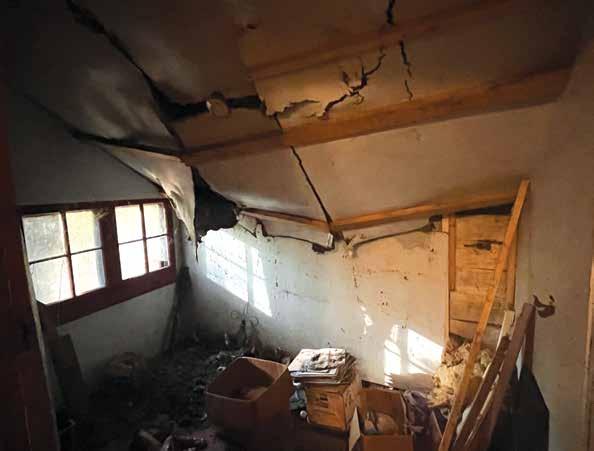
a rare condition that requires her to get a surgical operation every six months, and the doctors at Duke Hospital are some of the few in the world with the exper tise to perform the procedure. If the cou ple is displaced from their Open Air Camp Road home—which they’ve inhabited for the past 18 years—they’ll almost certainly have to leave Durham and will lose their proximity to the hospital.
And then there’s Sheba Everett, a tenant who is raising five daughters on her own. When Everett moved her family to Open Air Camp Road two and a half years ago, shortly after fleeing an abusive marriage, she found “a peace that her life needed.” She’d been displaced many times in the past, she says, and was relieved when Rich told her she could rent the house for as long as she wanted.
In February, Everett’s brother was mur dered. Her father-in-law had been murdered several months prior. Housing stability gave her the strength to support her children in the wake of these losses, she says.
Since receiving the notice to vacate, Ever ett has been looking for a house to buy. She’s determined to stay in Durham; gen erations of her family have lived there, and she has spiritual ties to the land.
But she can’t even afford the homes in the East Durham neighborhood where she grew up. She doesn’t understand how the ERA can justify putting her family out on the street.
“It seems like they care more about the land than the people,” Everett says. “Who are you conserving this land for? Who is it for, if not for me and my children? Who is it for?” W
14 October 26, 2022 INDYweek.com T O S U B S CRI B E , V IS I T indyweek.com/newsletter-signup L O C A L A R T S , MU S I C , F O O D , E T C . in your inbox every Friday the Triangle’s Arts & Culture Newsletter
A room in need of repairs in 1700 Open Air Camp Road
PHOTO BY LENA GELLER
voter guide
voter guide
Federal & North Carolina
U.S. Senate
Cheri Beasley
Judicial races
Supreme Court Justices
Seat 3 Lucy Inman Seat 5 Sam J. Ervin IV
nc court of appeals Seat 8 Carolyn J. Thompson Seat 9 Brad A. Salmon Seat 10 Gale M. Adams Seat 11 Darren Jackson






Local Races
Durham County
U.S. House 4 Valerie P. Foushee
nc senate District 20 Natalie S. Murdock District 22 Mike Woodard nc house District 2 Ray Je ers District 29
Vernetta Alston District 30 Marcia Morey District 31 Zack Hawkins
Durham DA Satana Deberry Durham Clerk of Superior Court Aminah Thompson Durham Sheriff Clarence Birkhead Durham Soil & Water District Supervisor David Harris NC Superior Court Judge District 14B, Seat 1 Brian C. Wilks nc district court 14 Seat 1 Dave Hall Seat 2 Doretta L. Walker Seat 3 Kevin E. Jones Seat 4 Dorothy H. Mitchell Seat 5 Clayton Jones Seat 6 Amanda L. Maris Durham County School Bonds
Durham County Community College Bonds
Durham County Museum Bonds

Orange County U.S. House 4 Valerie P. Foushee nc senate District 23 Graig R. Meyer

nc house District 50 Renee Price District 56 Allen Buansi Orange DA Je Nieman
Orange Sheriff Charles Blackwood Orange Clerk of Superior Court Mark Kleinschmidt Orange Register of Deeds
Mark H. Chilton NC Superior Court 15B, Seat 1 Alyson A. Grine NC Superior Court 15B, Seat 2 Allen Baddour NC District Court 15B, Seat 1 C. Todd Roper orange board of commissioners At Large Sally Greene District 1 Jamezetta R. Bedford District 1 (unexpired term) Anna Richards District 2 Earl McKee Orange Soil & Water District Supervisor W. Chris Hogan
Wake County U.S. House 2 Deborah K. Ross U.S. House 13 Wiley Nickel
nc senate District 13 Lisa Grafstein District 14 Dan Blue District 15 Jay J. Chaudhuri District 16 Gale Adcock District 17 Sydney Batch District 18 Mary Wills Bode nc house District 11 Allison A. Dahle District 21 Ya Liu District 33 Rosa U. Gill District 34 Tim Longest District 35 Terence Everitt District 36 Julie von Haefen District 37 Christine Kelly District 38 Abe Jones District 39 James A. Roberson District 40 Joe John District 41 Maria Cervania District 49 Cynthia Ball District 66 Sarah Crawford Wake DA
Nancy (Lorrin) Freeman Wake Sheriff Willie Rowe Wake Clerk of Superior Court Blair Williams
Wake board of county commissioners District 1 Donald Mial District 2 Matt Calabria District 3 Cheryl Stallings District 7 Vickie Adamson
Wake Soil & Water Conservation District Supervisor Jenna Wadsworth Alex Baldwin
Wake county board of education District 1 Ben Clapsaddle District 2 Monika JohnsonHostler District 3 Doug Hammack District 4 Tara Waters District 5 Lynn Edmonds District 6 Sam Hershey District 7 Chris Heagarty District 8 Lindsay Maha ey District 9 Tyler Swanson
Wake School Bonds Vote YES
Wake Tech Bonds Vote YES NC Superior Court District 10A, Seat 1 Paul C. Ridgeway
nc district court
District 10A, Seat 3 (unexpired term) Cynthia B. Kenney District 10B, Seat 1 David K. Baker District 10D, Seat 1 Margaret Eagles District 10D, Seat 4 (unexpired term) Rhonda Graham Young District 10E, Seat 1 Sam Hamadani District 10E, Seat 2 Louis Meyer District 10F, Seat 1 Jennifer Bedford
raleigh city council Mayor No Endorsement District A Mary Black-Branch District B Megan Patton District C Corey Branch District D Jane Harrison and Jennifer Truman District E David Knight At Large Jonathan Melton and Stormie Forte or Anne Franklin City of Raleigh Parks Bonds



Vote YES

INDYweek.com October 26, 2022 15
(clip-out!)
INDY Week TheINDY’s 2022Midterms Endorsements
Vote YES
Vote YES
Vote YES
Raleigh City Council, Mayor, & Parks Bond Raleigh City Council, Mayor, & Parks Bond
It’s been a long three years here in Raleigh, marked by the outbreak of a global pandemic, the unceremonious dissolution of the city’s main forum for residents to communicate with the leadership, a month of protests in response to police brutality, a council member’s resignation over sexual misconduct allegations, and a general election that ushered in a new president for the country and an affordable housing bond for the city.
And that was just 2020.
As rents and housing costs have skyrocketed (over the last year, rents in Raleigh rose by an average of 14 percent, home prices have risen by 22 percent, and homelessness has doubled) and construction pushes forward, it is good to see that the dialogue around Raleigh politics this election cycle has (mostly) transcended the terminally inane, offensively reductive YIMBY/NIMBY discourse. And as development has largely been deregulated across the city, it’s time now, in earnest, to have the tough conversations around displacement, gentrification, the soaring cost of living, and how we will house the city’s poorest residents without pretending that the market will take care of all that on its own. We will also need to think about city planning in the wake of the pandemic, when many have switched to working remotely, and to evaluate how well the city reaches out to residents and gets them engaged in government decision-making if the citizen advisory councils (CACs) really are well and truly gone.
The city’s leaders have made good policy strides addressing growth—they passed an $80 million affordable housing bond, ended exclusionary zoning, implemented a missing middle housing policy,
ended parking minimums, made bus fare free, and navigated the emergence of Bus Rapid Transit and commuter rail.

But displacement is rampant, and the availability of new affordable housing units isn’t anywhere close to keeping pace with the loss of them. The council could be far more aggressive in negotiating community benefits from developers in exchange for upzoning.
The council also added a police advisory board and a mental health crisis unit, but data and public perception suggest that these have been ineffectual so far; officer shootings continue and there have been basic missteps such as not activating the city’s alert system during this month’s mass shooting (though we have seen positive change under Raleigh’s new police chief). Finally, after three years, the city council has failed to deliver any kind of meaningful replacement for the CACs (we’re waiting to see what the city’s new office of community engagement will do).
CACs in their former iteration had their manifest problems, and maybe they did need to go. But not abruptly, not without input from the constituency, and not without another system for community engagement at the ready. We were also troubled by how the decision was made to move the municipal election from 2021 to this year, again behind closed doors, without public input, in a process so opaque that it garnered a rebuke from the governor, good-government groups, and local Democratic lawmakers. The switch on its face wasn’t a bad one—but why go about it that way?
Overall, the council has done good work manag-






The INDY’ s 2022Midterms Endorsements
ing Raleigh’s explosive growth and preparing for the much larger Raleigh that the city will become, but voters will have to decide if the ends justify the means. With three council members declining to run for reelection, it’s a guarantee there will be at least three new faces on the city’s governing board. We think they need to bring a balance to the council, leaders who favor dense mixed-income development in the urban core but who don’t equate thoughtful density with being antigrowth; leaders who have roots in the community and whom residents trust; and leaders who have some knowledge and experience of how government works. And we need leaders who believe in transparency, due process, and the value of receiving input from residents, partners, and experts. Raleigh deserves no less than this.
So, before we begin, here are a few notes on our endorsements: They were made collaboratively with input from our editorial staff. They were made based on our reporting, on candidates’ platforms, on public records, and on input from our sources and readers. In some races, we’re not endorsing at all. In some, we’re endorsing more than one candidate. We encourage readers to consider their values and what they care about most as they head into the voting booth. Read our coverage. Read our candidate questionnaires. Learn as much as you can. And know that we tried to make the best endorsement decisions possible with the information we have available.
Thank you for continuing to look to INDY Week as an election resource.
—The INDY Week editorial team
16 October 26, 2022 INDYweek.com
Wake County
mayor No Endorsement
Candidates: Mary-Ann Baldwin, DaQuanta Copeland, Terrance Ruth

Despite what her critics will tell you, we believe Raleigh mayor Mary-Ann Baldwin cares about the future of Raleigh and its residents. What she doesn’t seem to care about—and it’s an admirable quality in most other contexts—is what people think about her. These traits have coalesced for a productive first term as mayor.
Baldwin got the affordable housing bond passed and, while it’s not enough on its own— the city loses 4,000 affordable units each year—it is supporting Raleigh’s goals of building 5,700 affordable units by 2026, assisting homeowners, and acquiring land for the city to plan affordable housing in the future. Baldwin and the council implemented missing middle text changes to the city’s master plan that makes it easier to build apartments, townhomes, cottages, duplexes, quadruplexes, and accessory dwelling units (ADUs) in all areas of the city, which will provide homes (if not necessarily below market rate) to more people. The council expanded assistance for seniors and disabled residents, secured funding for Bus Rapid Transit, did away with parking minimums, made bus fare free, kept but regulated electric scooters, and provided assistance to small businesses. And a parks bond that will bring new greenways, help transform Dix Park, and improve other parks and green spaces across the city will likely soon pass, too.
That’s a solid list of accomplishments.
On the other hand, Baldwin spearheaded the effort to abolish CACs. The CAC system was riddled with problems, but whipping up votes in month two in office in order to get rid of an almost 50-year-old institution with no public input, no notice, and no backup plan for community engagement angered all kinds of people. Then, Baldwin and the council voted, in a closed-session meeting, to move the 2021 municipal election to 2022, giving her and her fellow council members a bonus year in office. These, to us, were Baldwin’s main missteps as mayor.
But Baldwin has a staunch coalition of supporters who clearly believe she’s taking the city down the right path as ardently as her critics, who mounted a fruitless effort to recall her, believe she isn’t. The thing is, Baldwin doesn’t seem to care what her critics say. She doesn’t care about the perception that she’s beholden to developers by accepting their considerable campaign donations, or taking a job at a construction firm that’s regularly awarded city contracts, or working for a golf foundation with developers on its board. She doesn’t care about bad press from hockey game dustups, or feral cat regulations, or viral vape tweets, or creating a board for African American affairs, or rebukes from the governor or fellow Democrats. She certainly doesn’t care about Livable Raleigh.
It’s Baldwin’s prerogative not to care about those things, some serious, some decidedly less so, but they’ve created problems for the mayor all the same. The trust deficit that Baldwin’s




District A
Mary Black-Branch
Candidates: Mary Black-Branch, Catherine "Cat" Lawson, Whitney Hill
Whitney Hill is a small business owner running on a law-and-order platform. He’s not our first or second choice for District A.
Cat Lawson, an attorney and lecturer at Duke, has a detailed platform that includes investing in flexible housing options, strengthening water, sewer, and transportation infrastructure, and preserving green spaces. A former member of the city council’s study group on council terms and compensation, Lawson is also the only candidate whom we’ve seen call for enacting ethics reforms by which city council members would be required to file Statements of Economic Interests. That’s good-government practice and could be a step toward rebuilding trust between representatives on council and the constituency.
But we feel that Mary Black-Branch, a community organizer, climate scientist, and envi-





opponent, Terrance Ruth, speaks of is real—and that’s why we’re not endorsing Baldwin.
But we’re not endorsing Ruth either.
Ruth, an NC State lecturer, is insightful, sincere, obviously smart, and by all accounts caring and engaging. And while he has run an admirably civil two-year-long campaign for the mayor’s office, Ruth lacks experience in governing that we feel is preferable to have under the belt to run a city of Raleigh’s size, and at the rate it’s growing, and with its billion-dollar budget.
Ruth has intriguing ideas, such as creating a department and master plan dedicated to affordable housing within city government and keeping a city database to track affordable units as they’re added and lost. He says he favors growth and urban densification and touts an aggressive approach to securing affordable housing. On top of that, people just seem to trust him.
Ruth could do the job of mayor, but the learning curve is steep and experience matters. While Ruth has plenty of accomplishments in social work, administration, education, and community organizing, having experience in municipal government is not nothing for this role, and it is something Ruth lacks.
DaQuanta Copeland, the vice chair of the Wake County Health and Human Services Board and employee of the College Foundation of North Carolina, is also running a grassroots campaign for Raleigh mayor. A single mother, renter, and longtime resident of Southeast Raleigh, Copeland is an advocate for those displaced by rising property values and a high cost of living. But how Copeland would help those people, beyond listening to them, isn’t clear. Her platform isn’t very detailed, and she doesn’t offer much in the way of policy proposals.
By not endorsing a candidate, we’re not at all saying don’t vote for your next mayor. If trust in public officials and open lines of communication are the values that are most important to you, vote for Ruth. But if experience, a record of achievements, a knowledge of government, and preserving the city’s forward momentum is your draw, vote for Baldwin.
May the best mayor win.
ronmental activist who has served on Raleigh’s Environmental Advisory Board, would be an excellent new addition to the council.
During a period of rapid growth, environmental concerns around development within the city sometimes feel as if they’ve fallen by the wayside. It would be good to have a representative on the council who is knowledgeable about environmental issues and will advocate for sustainable policies and practices. As Black-Branch says, the environment and the current climate crisis is “one of the most existential considerations for the future of every city.” As a community organizer who grew up in Raleigh, Black-Branch has deep connections to the people of her district and we hope she will be a voice for the younger and minority contingents who say they feel unheard.

INDYweek.com October 26, 2022 17
Raleigh mayor & city councilraleigh mayor & city council
INDY endorsementsWake County
Mary-Ann Baldwin
PHOTO BY ALEX BOERNER
Terrance Ruth
PHOTO BY JADE WILSON
DaQuanta Copeland
CONTRIBUTED
PHOTO
Raleigh
District B
Megan Patton
Candidates: Minu Lee, Jakob Lorberblatt, Megan Patton, Jeremiah "Frank" Pierce



The two strongest candidates in this race for retiring council member David Cox’s seat are Minu Lee and Megan Patton. We like both but are endorsing Patton.
Minu Lee is a college student at NC State University, the son of immigrants who own a small cleaning business, and a substitute teacher for Wake County Public Schools. A Korean American, Lee is endorsed by the National Asian American PAC and would bring a perspective to the council that’s well represented in his growing district but rarely represented in city government. Lee’s platform is also solidly pro-housing, with an eye toward improving infrastructure and encouraging entrepreneurship. But at age 21, we’re not sure Lee has the experience he’d need to represent a district that encompasses so many disparate groups of people.
Megan Patton lacks political experience, too, but she has notable professional and civic experience—as a customer service manager at a local company and a volunteer with Moms Demand Action—that speak well to her being prepared to represent District B. A mother and advocate for families and working people, Patton has a thorough grasp of the housing dearth that Raleigh currently faces and a thoughtful approach to addressing it that’s not just rubber-stamping. Patton doesn’t pretend to have all the answers, but she expresses a willingness to learn and, more importantly, to collaborate.
Frank Pierce is a small business owner from southeast Raleigh. He ran for a state house seat this spring, and his platform as a municipal candidate isn’t terribly detailed. Jakob Lorberblatt is also running for the seat but doesn’t have a very detailed platform either.
District C
Corey Branch
Candidates: Corey Branch, Wanda Hunter, Frank Fields
We think Corey Branch has done a good enough job over the past three terms to earn our endorsement again as District C representative over challengers Wanda Hunter, a nonprofit worker and staunch advocate for social justice, and small business owner Frank Fields.
In 2019, Branch was on the right side of the vote to abolish CACs. He has also done important work for the district advocating for more grocery stores in food deserts, prioritizing transit as chair of the Transportation and Transit Committee, volunteering for the Raleigh Transit Authority, and working on tax relief for retired homeowners. His critics say Branch isn’t as engaged with the concerns of his majority-Black district as he could be, but it’s not clear how his opponents, who don’t offer much up in terms of detailed policy specifics, would do better. Branch is an experienced leader on Raleigh’s council. We need that and we’re endorsing him for another term.

District D
Jane Harrison and Jennifer Truman
Candidates: Jane Harrison, Jennifer Truman, Todd Kennedy, Rob Baumgart
This was our most difficult endorsement to make as there are two energetic and accomplished candidates running to represent District D. We decided to endorse them both.
Jennifer Truman is an architect and self-described optimist, and her contributions to the city are considerable. An active member of the Southwest CAC before the groups

council
endorsements
were disbanded, Truman understands that, though imperfect, one of the strengths of the CACs was facilitating community engagement (though she doesn’t support reinstating them). Truman contributed to the Dix Park master planning process, was a member of the community leader group for the Dix Edge study, and has served on the Raleigh Transit Authority for a year and a half. A mother of young children, Truman uses her bike and the public transit system to get around the district. She’s also a proponent and activist in the realm of urban agriculture.
Jane Harrison is also an excellent candidate who got her civic start leading the West Raleigh CAC, which she reestablished after CACs were dissolved to keep in communication with her neighbors in the district. An NC State researcher and a specialist in natural resources management, Harrison is no stranger to collaboration with city and elected officials. She embraces growth and has ideas about how to build on existing policy, such as embedding an affordability component to Raleigh’s new missing middle housing policy, as well as adding environmental protection and community engagement measures. Harrison says Raleigh needs an anti-displacement plan and looks to cities such as Portland as examples of how to approach that.
Environmental consultant Todd Kennedy, who has served as chair of Raleigh’s Human Relations Commission and vice chair of the city’s Environmental Advisory Board, wouldn’t be a bad pick for this seat either.

Rob Baumgart, a self-employed landlord and small business owner, has a lot of business experience but not as much civic experience as the other candidates.
District E David Knight
Candidates: David Knight, Christina Jones
There have been grumblings from District E residents about David Knight’s willingness to engage with them, and he doesn’t hide his disdain for CACs, which he publicly called “inappropriate” and “undemocratic.” Still, we think he has a good idea of what's democratic and what's not: he was reportedly the only council member to cast a vote against moving the municipal election to 2022 in a closed session meeting.
Knight’s opponent, Christina Jones, says she is the longest-serving chair of the Raleigh CAC. While Jones definitely favors CACs and is a proponent of community engagement, she seems to be against most everything else. Jones doesn’t support infill development along transit corridors, the missing middle housing policy, or the elimination of the parking minimum. As a member of the city’s parks board for two years, Jones says she doesn’t support the city’s parks bonds. Jones seems to know what the city needs: affordable housing, more and better-staffed transit options, and yes, better community engagement. But she doesn’t put forward practical ideas to get us there. Jones says she’ll advocate for inclusionary zoning (currently a legal land mine due to state laws) and light rail (would be nice, but that’s not in the cards).
With the influx of newcomers to the city council, District E would do better to stick with someone who has experience governing. This year, that’s David Knight.
At Large
Jonathan Melton, Stormie Forte or Anne Franklin
Candidates: Jonathan Melton, Stormie Forte, Anne Franklin, John Odom, Joshua Bradley, Portia Rochelle, James Bledsoe
For the two city council at-large seats Raleigh residents may vote for, we’re again endorsing candidates with experience in city government. We're, again, endorsing more candidates than there are seats because we think there are three candidates who are worthy of your votes.
18 October 26, 2022 INDYweek.com
city councilraleigh city
INDY
Wake County
Local Races
INDY endorsements


For the first seat, we endorse incumbent Jonathan Melton, a family law attorney. Melton is a collaborative, thoughtful presence at the council table. He takes a pragmatic approach to governing and has a holistic understanding of the issues that affect all of Raleigh’s five different districts. Melton supports policies that he says he feels will support the city’s growth, including investment in transit and affordable housing. On the first point, Melton led the way on securing city contracts with electric scooter companies and they now operate in Raleigh with few issues. On the second point, Melton has supported policies such as legalizing missing middle housing that will provide more options for new housing that can be built across the city as opposed to limiting new construction to single-family homes. Melton takes the time to summarize each city council meeting, describing and explaining topics of discussion and clarifying any votes the council has taken in transparent, informative terms. And constituents say Melton is responsive to emails and social media queries and is always willing to engage in discussion. Melton has more than earned another term and we’re happy to recommend him.
For the second at-large seat, we endorse either Stormie Forte or Anne Franklin. Hear us out. Forte and Franklin both have experience serving in city government. Some say the time has come and gone for the 78-year-old Franklin and would like to see what Forte, who was appointed to fill Saige Martin's District D seat following his resignation, will do with another term in office. While Forte, an attorney, realtor, and court mediator, hasn’t mounted much of a campaign this election cycle we, too, would like to see what Forte does with another term.
On the other hand, Franklin, a community organizer, has been active in Raleigh city politics for a long time, serving three at-large terms in the 1980s and '90s. Since then, she has served on the Dix Park Conservancy’s Legacy Committee and chaired the board of directors for Southeast Raleigh’s Partners for Environmental Justice. Franklin has deep roots and strong connections in disparate Raleigh communities and has a proven ability to work collaboratively to get things done.
Disclosure: Franklin is a former neighbor of INDY Week editor Jane Porter.

City of Raleigh Parks and Recreation Bonds









Vote YES
We already know parks and green spaces promote health, wellness, and a higher quality of life for residents. They also protect water quality, remove air pollution, and provide spaces for people to connect with one another, as we saw during the height of the COVID pandemic. Recently, researchers have even found correlations between more green space and less crime.
Raleigh’s $275 million parks bonds proposal creates several new greenways and pays for wide-ranging improvements to new and existing parks, including expanding the tennis courts at Biltmore Hills Park, with related infrastructural improvements; stream restoration, flood, and stormwater management at Devereux Meadows; and construction of an 18-acre Gipson Play Plaza at Dix Park.
The bond also provides funding for Phase II of the Chavis Park master plan, paying for a new aquatic center and outdoor pool at the Historic John Chavis Memorial Park. The Phase I improvements to Chavis Park have transformed this Southeast Raleigh space into an amenity that has enhanced the overall well-being of residents and visitors of all ages during the pandemic, and the community in Southeast Raleigh has advocated for improvements to Chavis Park for nearly two decades.
Yes, $275 million is a lot of money, and residents will see a bump in their tax bills. But we feel these bonds are a worthwhile investment in the city’s future and its residents, and we give them our full support.
INDY Week Press Club
INDYweek.com October 26, 2022 19
BECOME A MEMBER TODAY AT bit.ly/INDYWeekPressClub Help keep local journalism free and and accessible.
raleigh city council & parks bondRaleigh city council & parks bond
Raleigh
Common Ground
Can Democrats and Republicans find common-ground solutions to deter mass shootings?
BY ANNE BLYTHE backtalk@indyweek.com
The 15-year-old accused of killing five people and injuring two others in a Raleigh neighborhood last week was armed with a shotgun, a handgun, a hunting knife, and ammunition in a knapsack for shotguns and rifles.
Raleigh police chief Estella D. Patterson issued a five-day report on Thursday with details of the violent incident on October 13 that reverberated far beyond Raleigh’s Hedingham neighborhood.
Gov. Roy Cooper called it an “infuriating and tragic act of gun violence” the day after the shooting occured.
President Joe Biden issued a statement in which he called for action in Congress to ban assault weapons. He also mentioned the gun safety bill he signed into law in June shortly after the mass killings in Uvalde, Texas, and Buffalo, New York. North Caroli na’s two Republican senators, Richard Burr and Thom Tillis, voted for it.
“We’ve grieved and prayed with too many families who have had to bear the terrible burden of these mass shootings,” Biden said. “Too many families have had spouses, par ents, and children taken from them forever.”
The suspect in the Wake County case, who has been identified by multiple news outlets as Austin Thompson, fatally shot and stabbed his 16-year-old brother James Thompson, according to the five-day report. Then, according to the report, he went on a shooting rampage that began shortly after five p.m. on a warm Thursday evening. The shooting spree ended at about 9:30 p.m., when the suspect was apprehended in a barnlike structure almost two miles away, suffering from what appeared to be a gun shot wound.
The report does not reveal the suspect by name nor does it provide a motive for the violence. It also does not say how or where the shooter obtained the weapons. After James Thompson was shot, law enforcement officers think Marcille Gard
ner, a special education teacher, was the next person injured. She was found in a driveway and is in critical condition at WakeMed. Nicole Connors, a walking buddy of Gardner’s and a human resources spe cialist, was fatally shot alongside her dog, which also was found dead.
Gabriel Torres, a Raleigh police officer who was in his car just about to head to work, was the next to be fatally wounded.
Two more victims were found shot to death on the Neuse River Greenway Trail, Mary Marshall, who was walking her dog, and then Susan Karnatz, an avid runner who was out for a run.
Police officer Casey Clark was shot while the suspect was hunkered down in the barnlike structure for what added up to a two-hour standoff.
As the community, Raleigh, and North Carolina mourn the victims and the loss of a sense of safety, lawmakers bemoan the many blockades they hit as they advocate for policies and regulations to deter gun violence.
Thoughts and prayers roll quickly and freely. New laws do not.
Calls for action
Earlier this week, Dan Blue, Democrat ic leader of the state senate, organized a briefing with reporters and other Demo cratic lawmakers to try to spur the Repub lican leadership in the General Assembly beyond the stalemate.
“Thoughts and prayers fall short … when they’re not followed up with action and change,” Blue said.
Blue has lived in the Hedingham com munity for more than three decades. It was not until the mass shooting hit so close to his home last week that he realized what happened in his neighborhood induces all-too-familiar fear and frustration.
PHOTO BY TOM DEF VIA UNSPLASH
“We always think when we hear the latest news of mass shootings that it can’t hap pen to us, that it can only happen in Denver or Boulder or Charleston or Sandy Hook or Uvalde or Buffalo or Parkland, and the list goes on endlessly, but not to us,” Blue said. “It can and it did.”
“Gun violence is an epidemic that has plagued our state and our country,” Blue added. “So far the actions seeking change have been one-sided.”
He noted that Democrats have been call ing for gun safety legislation for years.
“This is an issue that transcends party. It’s an issue about our safety, the safety of our children, the safety of our state, and it’s time that proposals be given serious consid eration,” he said.
Blue and others at the briefing with reporters said they respected the Second Amendment and were not putting forth proposals to infringe on anybody’s right to bear arms.

“I want to stress that gun safety reform and respect for the Second Amendment are not mutually exclusive,” Blue said. “We can have both. But it’s about more than just gun safety reforms. We also have to start taking mental health as seriously as we do our physical health. Our kids are in trouble, and we don’t make the resources available in our communities, and in our schools, to identify these issues before they become real dangers.”
That stance is similar to one put forth by the American Academy of Pediatrics, which recently released a letter noting that fire
arms are the leading cause of death for youth 0 to 24 years old. The group called for more education on gun safety, safe stor age, and safety regulations, as well as more mental health resources for kids.
Mental health needs
In July, Duke psychiatrist Gary Maslow described the youth mental health crisis as “the next wave of the pandemic.” A report from the Centers for Disease Con trol and Prevention noted that the pan demic had only exacerbated what already was a heightened concern about the mental health of adolescents and children.
At the briefing with reporters, Blue focused on the mental health needs of North Carolinians, knowing that mass shootings often are prompted by someone in a mental health crisis.
“North Carolina has 770 school psy chologists for 1.6 million students,” Blue said. “A conservative estimate says that we need at least 2,900 psychologists in our schools to meet their needs. Twenty-five school districts have no psychologists at all on staff. We have to get away from under funding and understaffing critical parts of our school systems, because our students will still suffer as a result.”
Kody Kinsley, secretary of the state Department of Health and Human Services (DHHS), has said repeatedly that behav ioral health needs will be a focus of any post-pandemic plan. Blue hopes to per
20 October 26, 2022 INDYweek.com N E W S
suade lawmakers on both sides of the polit ical spectrum of the importance of funding such efforts.
“Our kids are coming out of the COVID shutdown,” Blue said. “They’ve also missed two years of the socialization, identifying with their classmates, figuring out jointly how to solve problems, and how to address many issues, and we need to know that we’re putting in place the machinery and the apparatus that help them get over that and help them grow into adults in an unso phisticated, uncomplicated way.”
“Mental health is something that we have the resources to do something about, something that is becoming acute in our state and our nation,” Blue added.
Any room for common ground?
Rep. Robert Reives, a Chatham County Democrat and the house Democratic lead er, lamented the politics that can infect the gun safety reform debate and some of the other thorny issues that come before lawmakers.
“At some point in time we stopped becoming a solutions-oriented govern ment, and that breaks my heart,” Reives said at the briefing with Blue and report ers. “It feels like every time we try to talk about solutions, they become political talk to the point where I almost feel obligated to say, ‘This is not about taking anybody’s guns.’ Nobody up here wants to take any body’s guns. This is not about good legal responsible gun ownership. It’s just about seeing there is a problem, acknowledging that there is a problem, and trying to get some different viewpoints to help solve that problem.”
Reives advocated for small steps, ones for which he hoped there could be bipartisan support. He noted that DHHS estimates some 2 million North Carolinians will expe rience a mental illness or substance use disorder.
“We don’t do things to help our commu nities take care of themselves,” Reives said.
House speaker Tim Moore, a Republican from Kings Mountain, released a state ment after the Democratic lawmakers’ briefing, according to WRAL, saying law makers “should remain focused on pray ing for the victims’ families and supporting law enforcement rather than seizing the moment for a political debate.”
Red flag law proposals
Since the 2018 mass shooting in Park land, Florida, Rep. Marcia Morey, a Dem ocrat from Durham and a former district
court judge, has put forward proposal after proposal for extreme-risk protective orders, or “red flag laws.” They have not gotten a hearing in committees in the Republi can-controlled chamber.
Ten bills have been introduced on the house side since Parkland, Morey said, “to address commonsense gun safety. Zero hearings.”
Senate leadership has not given a hearing on a Republican-sponsored bill that passed the house with sweeping bipartisan support to provide $150,000 to DHHS for an edu cation campaign on safe firearm storage that would include free gun safety locks.
This has been a proposal recommend ed for years by the North Carolina Child Fatality Task Force. In May, the task force presented its annual report to the governor that included the number of firearm-relat ed deaths and injuries to children over the past decade.
From 2011 through 2020, 525 children 17 and younger died from gun-related inju ries, according to the report. Of those, 105 deaths occurred in 2020, a year in which gun sales skyrocketed.
Although Democrats are most vocal about passing gun safety measures, the idea has bipartisan support at the state and federal levels.
The federal law offers incentives for states that adopt red flag laws. In Florida, one conservative-run state that already has a red flag law, the statute has been enacted thousands of times since its initial passage in the wake of the Parkland shooting. That state has seen a decrease in deaths by sui cide each year since the law’s passage.
Morey, who plans to put forward anoth er proposal in the next legislative session, and others at the briefing would like North Carolina to join the growing list of states with such laws.
“That’s not the long hand of the gov ernment coming in taking anything from anybody,” Reives said. “That’s a community saying, ‘We recognize that we have a mem ber in our community that we love and sup port and we want to help support that per son through a crisis, but right now during that crisis there are things they don’t need access to.’ A judge makes the decision. It’s a temporary decision. You get an opportunity for a full hearing.
“But we take more seriously somebody failing to wear a seat belt and then forget ting to pay that ticket.”
W

This story was originally published online at NC Health News. North Carolina Health News is an independent, nonpartisan, notfor-profit, statewide news organization ded icated to covering all things health care in North Carolina.



e up with us
INDYweek.com October 26, 2022 21
ka
WLocal news, events and more— in your inbox every weekday morning Sign up: indyweek.com/newsletter-signup INDY DAILY SIGN UP FOR THE
An Institution
A Durham supercentenarian celebrated her 110th birthday this month.
BY THOMASI MCDONALD tmcdonald@indyweek.com
F
or nearly 80 years, Catherine Spearman Ferrell has lived on a historic street in the shadow of the down town district, surrounded by institutions.
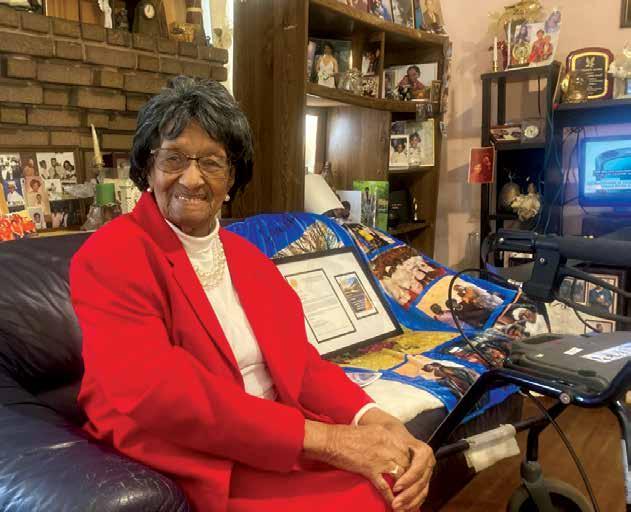
Now she is an institution.
Earlier this month, on Monday, October 10, Ferrell cel ebrated her 110th birthday.
To say the sweet-spirited, unfailingly gracious, devout, and bespectacled lady is living in rarefied air is an under statement. According to the Gerontology Wiki, there are about 60 living “supercentenarians” in the United States, and only three have been validated.
Ferrell, who moved to Durham’s Fayetteville Street in 1945, grew up in a two-room house with a fireplace in Warsaw, a Duplin County hamlet about 95 miles south of Durham. She was born in 1912, six months after the “unsinkable” Titanic’s fateful voyage. She is the oldest of two sisters.
The tiny dwelling did not have indoor plumbing or lights, and Ferrell still has the oil lamps her parents used to light their home.
“That’s what we had to study by,” Ferrell says.
Ferrell still has the pots and pans her mother would use to prepare family meals.
“Sometimes, we were so poor, when the stove failed, we had to cook over the fireplace,” she says. “We lived kind of tough. My momma would take in washing and ironing, and people paid her what they wanted to.”
Ferrell told the INDY that when she was a child she “mostly played by myself.”
“Hopscotch, and I loved to play marbles,” she adds.
Among the birthday well-wishers were President Joe Biden and Gov. Roy Cooper.
“Your strength and perseverance have helped shape this Nation into what it is today and define what it means to be a member of the Greatest Generation,” Biden wrote. “This milestone serves as an inspiration to your fellow Americans.”
“The strong men and women of your generation invest ed decades of aspiration, diligence and devotion in mak ing a better state and country, and we are deeply grate ful,” Cooper wrote.
Attendees at a brisk late Sunday morning birthday party for Ferrell at Durham’s Central Park, hosted by her fellow members of Mt. Gilead Baptist Church, includ ed state lawmakers Mike Woodard, Marcia Morey, and Natalie Murdock and a representative from the office of Vernetta Alston.
Woodard noted that during Ferrell’s lifetime, there have been 20 U.S. presidents, 23 North Carolina governors, and 21 Durham mayors.
“We haven’t seen a woman elected president yet, but you hang in there and I think we might get there,” Wood ard told Ferrell, who was seated beside a portable heater to knock the cold out of her bones.
A little later during the worship service and birthday celebration, Durham sheriff Clarence Birkhead deputized Ferrell, asking her to stand, raise her hand, and take the oath of office, before calling her “the oldest living Durham County deputy in history.”
Even with the heartbreaking announcement this month about the closing of the NC Mutual Life Insurance Com pany, the generator of Black wealth in the community since its founding in 1898, the Fayetteville Street corri dor where Ferrell has lived since the end of World War II
is still chock-full of historic institutions like NC Central University, the Stanford L. Warren Library, the Pearson School, the Lincoln Community Health Center, the Hayti Heritage Center, the White Rock and St. Joseph’s church es, the W.D. Hill Recreation Center, Hillside High School, and Hillside Park.
Now, with a life that has straddled two centuries, Ferrell has lived long enough to survive two pandemics and two world wars, while enduring Jim Crow and white mob vio lence, experiencing the invention of television, the mass manufacture of the first American-made car, laws prohib iting women from voting, the civil rights movement, and the election of a Black president. She was a teenager play ing on her school basketball team when the stock market crashed, graduated class valedictorian, and is older than seven of the world’s 10 oldest airports.
One day after the church’s birthday party, Ferrell invited this writer to her home. Entering her home on her birth day was like walking into a history museum.
Among the hundreds of photos lining the home’s liv ing room walls and shelves are sepia-toned photos of her parents, children, and in-laws dating back to the early 1900s and before.
“See how they dressed in the old times?” she asks. “Now these folks go out here half-naked.”
A 2017 edition of the old Carolina Times chronicled Ferrell’s 105th birthday. There’s a picture of her first child, Margaret, taken during the 1920s, an autographed photo of NBA Hall of Famer Nate “Tiny” Archibald, a cornucopia of photos showing smiling children, grandchil dren, great-grandchildren, and great-great grandchildren, along with dozens of plaques and certificates, includ
22 October 26, 2022 INDYweek.com N E W S Durham
Catherine Spearman Ferrell PHOTO BY THOMASI MCDONALD
ing one from the Durham chapter of the National Council of Negro Women that was founded in 1935 by civil rights giant Mary McLeod Bethune.
“I went to visit Mary McLeod Bethune’s office one time,” Ferrell says.
A picture of former president Barack Obama presides over one living room wall.
“I didn’t know if we would ever have one,” Ferrell says about Obama’s historic elec tion as the nation’s first Black president.
Obama’s photo sits next to a picture of Ferrell posing with Hillary Clinton. There are also photos commemorating Ferrell’s trip to Israel to celebrate her 100th birth day. More than a decade later she remem bers seeing the places she visited when ever she reads her Bible. She jokes that the flight was her first and last time on an airplane.
“I won’t go up there anymore,” she says while smiling.
Still, Ferrell says her pilgrimage to the Holy Land was “just amazing.”
“I can’t remember all of the places I vis ited,” she says. “When I read the Bible they come to me: the Jordan River, Mt. Sinai, and where Jesus was buried.”
Ferrell says she didn’t hear about the stock market crash or the 1918 flu pan demic that, according to the Centers for Disease Control and Prevention, killed about 50 million people across the globe.
Ferrell explains that radios, the avail able means of mass communication about important events—even battery-operated devices—weren’t readily available in her community.
“If we didn’t hear about it through school, we didn’t know about it,” she says.
Ferrell says she rode on the back of a horse-drawn wagon to school up until the fifth grade, and enrolled at Frederick Dou glass High School, where she completed
her studies in the 11th grade.

She reckons it was a year or two out of high school when she met Walter Wil liams, her future husband, at church.
Someone, she explains, “set me and him up.”
“He picked me up at my house and we started going out together,” she says.
“Then we got married.”
Of course, “picking up a date” in rural, hardscrabble North Carolina during the 1920s didn’t involve the luxury of a car.
“We walked everywhere we went,” she says. “We would go to the movies. Most of the time we would just sit at my house and talk.”
Ferrell does not recall acrimonious rela tions between the races while coming of age in Warsaw. After high school she worked as a domestic for a white family that “helped you out all they could.”
“Everyone,” she adds, “worked for white folks, mostly in the [farm] fields. I had the right idea. I worked in the shade.”
Still, not even life in the rural backwoods of an eastern North Carolina hamlet could shield her from the realities of Jim Crow.

“You couldn’t drink out of the [white] spig ots,” she recalls with a bemused twinkle in her eyes. “They thought water was colored. You couldn’t go to the same bathrooms. Uptown at the stores, it was segregated.”

Ferrell says she didn’t march during the civil rights movement, but her daughter and pastor attended the 1963 March on Wash ington, where Martin Luther King Jr. deliv ered his immortal “I Have a Dream” speech.
After her first marriage ended she moved to Durham in 1945, looking for work. Ferrell eventually joined Mt. Gil ead Baptist Church and remarried May nard Ferrell, who was a delivery man. They first settled into a home in East Durham, then lived for a spell on Eliz abeth Street while saving part of their earnings to purchase the home where she currently lives.
Ferrell, who lived in the Hayti District during its peak years, says “she liked it very well,” although a long life offers up a unique bittersweetness.
“Everybody that I knew when I moved here is deceased,” she explains. “Everyone was neighborly. We talked with one anoth er. I can still recall our neighbors. It was not like it is now.”
Ferrell had two more children, David and Shirley Ferrell. It was a fruitful time. In addition to joining the National Coun cil of Negro Women, she became a mem ber of the Elks and stayed busy in church, where she taught Sunday school and drove a church van.
Her dad died “early,” she says, but her mother lived until the age of 95. She remembers her great-aunt, who doted on her and slept with her in the kitchen of the two-room home in Warsaw until her sister was born.
“One night I told her I was hungry and she got up to fix me something to eat,” Ferrell says. “Then she sat down at the kitchen table and died. I was three.”
Indeed, in her 110 years, Ferrell has not been immune from crushing heartbreak.
“My son and my grandson got killed,” she says. “People just shot them down.”
Still, the wisdom that comes with over a 100 years of living sustains her and makes her all the more appreciative of the rhythms of life.
“My son is gone, and his son just had a son that looks like [my slain son] spit him out,” she says.

Then Ferrell ladles out a heaping helping of wisdom we can all live by, at age 10 or age 110.
“Learn to love one another,” she coun sels. “You don’t have to live with everybody, but you can love and respect other people. The Lord brought us here, and He is going to take us away, and we ought to learn to live and love together.” W
INDYweek.com October 26, 2022 23 YOUR WEEK. EVERY WEDNESDAY. FOOD • NEWS • ARTS • MUSIC INDYWEEK.COM
“Learn to love one another. ... You don’t have to live with everybody, but you can respect other people... We ought to learn to live and love together.”
The two-room house in Warsaw, where Ferrell grew up
PHOTO BY THOMASI MCDONALD
THE POWER
Friday, Oct. 28–Sunday, Feb. 26, 2023 | The North Carolina Museum of History, Raleigh | ncmuseumofhistory.org/exhibits/power-women-country-music
Honky Tonk Gals
A traveling GRAMMY exhibition showcasing the sterling, enduring presence of women in country music, lands in Raleigh.
BY AMANDA WICKS arts@indyweek.com
Emmylou Harris, boots from Blue Kentucky Girl album cover, 1979

PHOTO COURTESY OF THE GRAMMY MUSEUM®/ REBECCA SAPP
ountry music is said to revolve around “three chords and the truth.” But the truth is that, despite a progressively diverse roster of talent, the genre’s history has tended to heavily emphasize white men.

At the time, Hill’s rhetoric received significant flak, though that did little to change things. Women have continued to struggle with terrestrial radio, where visibility in country music arguably matters most.
“The history of the music itself goes back to Black women and people in the South,” says Goelz. “They’ve been there the whole time, but they’re finally getting their due.”
heavily emphasize white men.
Music
the


























The Power of Women in Country , a new exhibit coming to the NC Museum of History from the GRAMMY Museum on October 28, spotlights the women who shaped country music and those who continue to propel
spotlights the women who shaped country music and those it forward.
The impetus for the project occurred a few short years after Tomato-gate in 2015, when radio consultant Keith Hill discussed the issue of gender parity on the radio by crafting one limp metaphor: In the salad of country music, he explained, men were lettuce and women were tomatoes. Playing too many tomatoes distorted
salad try music, he tomatoes distorted the dish.
It doesn’t seem to matter that Kacey Musgraves became the rare country artist to win Album of the Year at the 2019 Grammys or that Miranda Lambert is now the most-awarded musician in the Academy of Country Music’s history. As of 2019, women still comprised just 16 percent of airplay.
The GRAMMY Museum set out to help change that erasure with a traveling exhibition that landed in cities like Tulsa and Los Angeles prior to Raleigh.
“We wanted to shine a light on not only the contemporary women in country music but also the ones who came before them and show how important women have been this whole time,” says Kelsey Goelz, associate curator at the GRAMMY Museum.
The exhibit material is featured chronologically, beginning with country music’s purported inflection point in 1927, when the Carter Family traveled to Bristol, Tennessee, to record with producer Ralph Peer. “The show takes you back and shows you that people have been working hard so the Kaceys and Mirandas can do what they do,” Goelz says.
“Some of the most groundbreaking stuff that’s happened in country music has happened because of women,” says the Durham musician Rissi Palmer, who also hosts the Apple Radio show Color Me Country. Palmer is also featured in the exhibition.
Much of that history-making has taken place along gendered lines, but a growing number of artists, Palmer among them, have pushed for greater racial inclusivity as well. After all, many of the songs deemed “country” in the early 20th century were popular hymns, spirituals, and folk tunes that circulated in sundry communities.
Palmer’s inclusion feels especially important considering the growing spate of artists—Mickey Guyton, Brittney Spencer, Allison Russell, and Amythyst Kiah, among others—who are working to deepen country’s legacy.
“My inclusion as a Black woman shows the impact people of color have had on the genre,” Palmer says.
The Power of Women in Country Music features a wealth of objects that bring an ephemeral art form to life. Costumes from Dolly Parton and Loretta Lynn, among many others, sit alongside Shania Twain’s famous top hat and tuxedo jacket from her “Man! I Feel Like a Woman” music video.
“We wanted to show performance outfits and fashion, because I think that trickles into pop culture so much,” Goelz says.
Palmer donated the 1950s-style Betsey Johnson dress she wore during her first televised Grand Ole Opry performance.


“It means a lot to me to be able to go see it alongside LeAnn Rimes’s dress—or now Loretta Lynn,” says Palmer. “All these people that I looked up to and all these people that made music that mattered to me.”
Visitors will also get to see handwritten lyrics, and interact with certain instruments, like a dulcimer and autoharp.

The exhibit’s arrival in Raleigh brought an opportunity to expand the number of musician’s featured in the display. Katie Edwards, curator of pop culture at the NC Museum of History, pulled Emmylou Harris and Rissi Palmer from the main setup and placed them alongside four new additions: Myrtle Wiseman (aka Lulu Belle), Donna Fargo, Rhiannon Giddens, and Kasey Tyndall.
Like the GRAMMY Museum’s original curation efforts,
24 October 26, 2022 INDYweek.com MUSIC
OF WOMEN IN COUNTRY MUSIC
Rosanne Cash, custom Martin acoustic guitar
PHOTO COURTESY OF THE GRAMMY MUSEUM ®/REBECCA SAPP
the sheer abundance of North Carolina tal ent made it difficult to figure out whom exactly to include.
“It was hard coming up with those women because there are so many,” says Edwards. “But I decided to choose natives from all over the state.”
The museum will also host four con certs in a Southern Songbirds series to bring attention to the different North Car olina artists who play in and around coun try music. Durham singer-songwriter H.C. McEntire kicks off the series on October 29, along with Charly Lowry, who lives in Pem broke, and Caitlin Cary, who lives in Raleigh. The three following concerts will feature Triangle musicians Tift Merritt, Alice Ger rard, and Rissi Palmer.


“I grew up in North Carolina,” says McEn tire. “I grew up in the mountains, so coun try to me is much more than a genre—it’s more cultural.”
And that culture has been overdue for a shift, especially as more voices insist on new perspectives.
“As much as I am inspired by the coun try musicians that came before me, I chal lenge myself as a queer woman in the South playing music,” McEntire says. “I’m proud to be from the South and be creating art in the South. I also think with that comes a responsibility.”
Palmer is set to close out Southern Song birds on January 21. “I love the name of the series because I think that being coun try and being Southern are two different things. It’s not a monolith. All of our expe riences and influences are different, but it doesn’t make them any less authentic.”
McEntire echoes that sentiment. “There should be room for everyone,” she says. “Sometimes you have to elbow your way in a little bit. I think it’s starting to crack open in terms of visibility and opportunity, but there’s a long way to go.” W
INDYweek.com October 26, 2022 25
Don’t miss your favorite band in town. Follow @INDYWeek on Twitter, Facebook, and Instagram for breaking news.
!!
Hear about that great new BBQ place. Visit INDYWeek.com for restaurant reviews and food & drink news.
“There should be room for everyone. Sometimes you have to elbow your way in a little bit. I think it’s starting to crack open in terms of visibility and opportunity, but there’s a long way to go.”
How to Be an Iconic ’90s Band in 2022
Twenty-four years after their last album, Chapel Hill torchbearers Archers of Loaf are reborn in the fires of frustration on Reason in Decline.
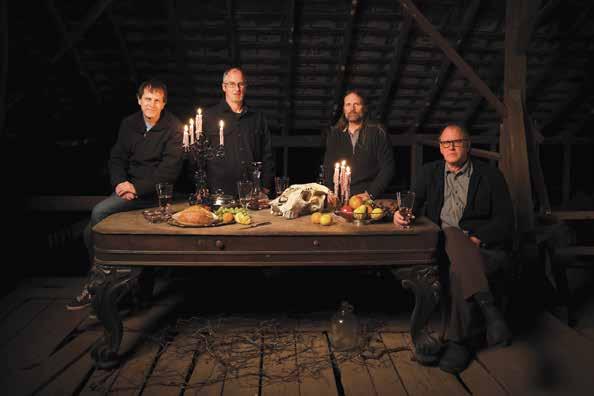 BY BRIAN HOWE music@indyweek.com
BY BRIAN HOWE music@indyweek.com
“Matt, my name’s Eric Bachmann, and I’m here to interview you,” the Archers of Loaf frontman says to bassist Matt Gentling, who’s been painting slant ed harmonic stripes on Bachmann’s racing rhythm guitars for more than three decades.
At first, I think this is a shtick for my bene fit. It would be such a classic ’90s indie band thing to do, hijacking an interview to make a mockery of the whole bullshit consumerist hype machine, and Archers’ avidity in this kind of role made them the ultimate ’90s indie band. I mean, they’re on the soundtracks of both Mallrats and My So-Called Life. By the time I realize they’re just joking with each other and don’t know I’m already on the call, the old friends are deep into catching up about their lives on tour. Mortified, I draw an interrogative breath, waiting for the slightest pause, before finally interrupting.
This was my mistake: I had mixed up the new Archers—who just released Reason in Decline, their first album in 24 years—with the old Archers, whose original run defined one serrated edge of the famed Chapel Hill sound and left behind enduring classics like Icky Mettle and All the Nations Airports
The old Archers wrote cramped, careen ing songs, but the new Archers peal and glide, their music smoothed and embel lished by Bachmann’s two decades as a folk-pop singer-songwriter. With his shred ded throat rehabilitated, he projects from the diaphragm, and instead of coded grous ing about scene politics and grievances, his lyrics are connective missives about world politics and wellness.
But some things never change. Though lead guitarist Eric Johnson and drummer Matt Price pop up in interviews on occasion, Bachmann and Gentling remain the band’s
de facto spokesmen, and their contrast ing dynamic—with Bachmann as the gruffvoiced contrarian and Gentling as his agree able, self-deprecating comic foil—somehow distills the contradiction that scorched the band’s catchy, splenetic anthems onto Gen X hearts forever.
In ’90s indie, suspicion and snark were just in the air, but Archers’ particular brand also partly stemmed from their contentious relationship with the ambitious indie label Alias. They broke up after 1998’s White Trash Heroes and left Chapel Hill, though they still think of it as home. Bachmann, who now lives in Athens, Georgia, embarked on his second act as Crooked Fingers. Gen tling eventually joined Band of Horses and now lives in the band’s native Asheville, where Johnson, a criminal defense attor ney, also lives.
An alternate timeline where Archers signed to Merge, which just released Reason in Decline, was inaugurated in 2011 when the label began to reissue their albums, sparking a reunion that spanned secret Cat’s Cradle shows, major festivals, and late-night TV. But the new music that everyone expected, the band included? It just didn’t come. After the refinements of his solo career, Bach mann found his smart-ass, griping Archers voice too callow to revive.
“I never got there,” he says. “As a young guy, I wasn’t really thinking it through, just letting it out. But you better be complaining for a good reason if you’re a 52-year-old white man.”
When Archers did eke out a new song, 2020’s comeback single, “Raleigh Days,” it wasn’t by letting go of the past but by tweaking it. The lyrics, in their classic style, seemed to congeal the chatter overheard in a rock club—in this case, Raleigh’s Fall
out Shelter in the early ’90s—into a clot of dreaming and scheming and thwarted ambi tion, though now at a certain wistful remove.
“At that time, it was very uncool to be ambitious,” Bachmann says. “It was lame to be in a band and want to be financially successful. I was kind of making fun of that attitude, which I used to have. Even as a kid, I was like an old man.”
“He wore wing-tip shoes!” Gentling interjects.
“Raleigh Days” came out one month before the pandemic, and after three decades on the road, Bachmann suddenly became the stay-at-home dad of a toddler while his wife worked as an ICU nurse. The high stress led to the mental health crisis he sings about on “Human” and “Breaking Even.”
“When you’re in the throes of a mental issue, you don’t write, and all the songs came in 2021 after I got help,” he says.
“All these amazing new songs came flooding out of nowhere,” Gentling recalls. “He was sending demos that didn’t have drums or bass or secondary guitar, and I love that he left it like that so it wouldn’t color what we came up with. It was really fun to just go berserk with them.”
“The truth is, half the cool guitar-tex ture stuff that happens is what Matt adds to it,” Bachmann counters. “I don’t know if you know what you’re doing, Matt, but you make the chords sound more innovative than they are.”
Gentling, of course, says that he definite ly doesn’t know what he’s doing.
Reason in Decline is an antiwar record, an anti-Trump record, but in true Archers fash ion, it reserves some of its sharpest barbs
for guilt and privilege within.
“While I enjoyed the batch of songs we did before the pandemic, the new record definitely has a more focused approach, singing about the sociopolitical climate and mental health,” Bachmann says. “I thought that if I was making a rock record, which is what the Archers would do, it was gonna have to have a sort of antagonistic ener gy to it. There was plenty to be frustrated about, which was a curse but inspired me to come up with something I thought would honor the Archers’ past.”
Though the new songs sound unmistak ably Archers, born as they were in the fires of frustration, the droning no-wave influ ences of the early days have given way to broader pastures.
Archers are taking the new record on tour, though Asheville is the closest to the Trian gle they’ll come until a yet-to-be-announced local date in the spring. But if the stakes feel lower than they did in ’90s Chapel Hill, the purpose gleams clearer than ever.
“The reason we’re doing this is that we like each other, and we have chemistry,” Gentling says, and Bachmann jumps in.
“That’s the thing right there, Brian. Chemistry is what makes legendary bands legendary. You play for 20 years without realizing you have it and then miss it when it’s gone. The liberating thing was to stop worrying about it”—all of it, the Archers brand, the whole heavy Chapel Hill altrock legacy—“and focus on the chemistry. I thought I didn’t want to do rock records anymore. But what I realized is that I really didn’t want to do it without these three.” W
26 October 26, 2022 INDYweek.com
M U S IC
ARCHERS OF LOAF: REASON IN DECLINE
[Merge Records; Oct.
21]
Archers of Loaf PHOTO BY KATE FIX
BREAKAWAY
Along for the Ride
With their twin cafés, Amy Coughlin and Andy Pignatora hope to cultivate an inviting community for cyclists and pedestrians alike.
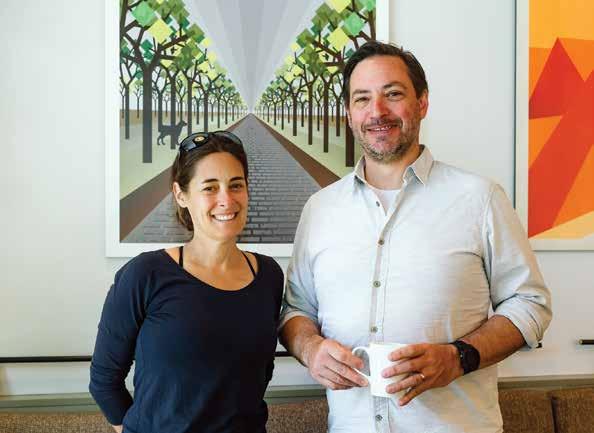 BY GABI MENDICK arts@indyweek.com
BY GABI MENDICK arts@indyweek.com
Whether at home or at work, husbandand-wife duo Andy Pignatora and Amy Coughlin seem to instinctively bring people— and animals, for that matter—together.
At home in Chapel Hill, in addition to two children, they currently house 12 cats and two dogs. Their restaurants offer sim ilar, welcoming spaces that aim to serve the community more than just delicious food. The owners of Breakaway Cafe, which opened in Briar Chapel in 2016, recently expanded to Carrboro, where lat est venture Breakaway Carrboro opened for breakfast and lunch on August 1.
Looking back to the beginning of Pig natora and Coughlin’s journey, their story could be the plot of a romantic comedy. Long before opening their own restaurants, the couple first met in 1998 working at SPoT, a coffee shop in Buffalo, New York. It was a meeting that foreshadowed where they’d eventually end up, but first, there were some twists and turns along the way.
Coughlin was working in public health and Pignatora in action sports sales in 2008, several years before their joint business endeavors, when their experience on a bike trip with Cycle Oregon sparked the idea that would eventually take form at Breakaway. The trip’s joint focus on biking and food awakened them to the notion of a business that married their shared passions.
“It’s 2,000 people riding bikes, eating awesome food, drinking really good coffee,
beer, wine, and music,” Pignatora recounts. “Just bikes, community, and food. We came back with the idea that that would be awesome to have where we live. A guy was opening a place like that two towns over from us, so we put it on the shelf.”
In 2011 Coughlin and Pignatora moved to North Carolina, and in 2016 when they were settled in, the timing and location were finally right to open Breakaway.
“There’s 20-something miles of trails built into Briar Chapel for biking,” Pignatora explains. “The roads out there are still pret ty accessible for road bikes. We get groups in every weekend from Raleigh, Cary, Apex, out toward Hillsborough. People come from Carrboro out to Mebane, then Briar Chap el, get coffee, and then come back up here where their cars are parked. It’s been a linchpin sort of spot for that café culture that we wanted.”
While the original location is accessible by bike, the Carrboro location caught the pair’s interest because of its walkability and proximity to downtown Carrboro and Chapel Hill.
“That rooted feel of being someplace where people are around was something that was super compelling to us,” says Pig natora. Coughlin also notes that they were aware of a lack of healthy, casual breakfast and lunch options in Carrboro, a gap that they hope Breakaway will help fill.
Breakaway’s menu is built around brunch.
“I’m hyper-obsessed with Australian
brunch culture—from the coffee to the way that they treat ingredients and presentation; that’s something that’s super compelling to me,” Pignatora says. “My wife’s coming at it from a different angle. She does a lot of menu development; she doesn’t know how to cook, but she has an impeccable palate.”
Pignatora explains an unexpected sim ilarity, comparing Australian cafés to the food in areas of Africa, noting Johannes burg, Cape Town, and Namibia, where Coughlin has spent time. The fusing of inspiration is seen in menu items such as the Mushroom Tartine: shiitake and king oyster mushrooms roasted with herbs, garlic, shallots, and butter on grilled bread with fresh ricotta.
When I visit Breakaway Carrboro on a Friday after the lunch rush, the bright, airy space is scattered with students sipping coffee while typing away on their laptops and clusters of friends chatting over sand wiches. The clientele at the original Break away Cafe skews slightly older, in addition to the regular groups of bikers refueling with hearty baked goods.
With the Breakaway spots, Coughlin and Pignatora aim to both pursue their passions and serve the community’s needs, which was evident in their response to the begin ning of the pandemic.
“All the produce vendors that we dealt with had a bunch of produce they couldn’t sell because restaurants were closed down, and nobody wanted to go to supermarkets
because they were freaked out about getting sick, so we were selling it on the patio,” Pig natora says, explaining how the pair turned the original Breakaway location into a make shift farmers market. “We bought, I think, three pallets of cabbage, because our main produce vendor, Blue Sky Farms in Wendell, had all this cabbage that was gonna go bad. Eventually, we found people to take it.”
Coughlin and Pignatora are also intention al about where the food they serve comes from. Most of the café’s menu items cost $10-$15, prices that take into account the extra cost of ingredients that are humanely certified, pasture raised, and cage free.
“We end up using a lot of the same raw ingredients that much-higher-end restau rants would use,” Pignatora shares. “You go in and you see the things that they’re tag ging on their menu being from this farm or that farm, and it’s the same stuff we use.”
Impressed by their commitment to their customers and how consciously they put their principles into action, I asked Pignato ra if his early experience working in restau rants taught him to go about things “that way” or “not that way.”
“There were a lot of ‘not that ways,’” he says. “Restaurants now are so different than they were 30 years ago or 10 years ago, the way that people approach the industry, the ways that people get into it, the commitment that they make. When I was younger restaurants were a haven for bad business.” W
INDYweek.com October 26, 2022 27
F O O D & D R I N K
CARRBORO | 410 N. Greensboro St., Suite 160, Carrboro BREAKAWAY CAFE | 58 Chapelton
Court, Chatham County
breakawaync.co
Amy Coughlin and Andy Pignatora, owners of Breakaway Cafe and Breakaway Carrboro PHOTO BY BRETT VILLENA
C
LT
The Airborne Toxic Event $25.
Wed, Oct. 26, 8 p.m. Cat’s Cradle, Carrboro.
Church Girls $10. Wed, Oct. 26, 8 p.m. Local 506, Chapel Hill.
Cory Branan $15. Wed, Oct. 26, 8 p.m. Cat’s Cradle Back Room, Carrboro.
An Evening with Jesse Fox $112. Wed, Oct. 26, 7 p.m. The Barn at Sonark Media, Hillsborough.
musicIbibio Sound Machine $20. Wed, Oct. 26, 8 p.m. Motorco Music Hall, Durham.
Jonathan Kreisberg Trio $25. Wed, Oct. 26, 8 p.m. Sharp Nine Gallery, Durham.
Twain $12. Wed, Oct. 26, 8 p.m. Rubies on Five Points, Durham.
Daniel Nunnelee $12. Thurs, Oct. 27, 8 p.m. Local 506, Chapel Hill.
Frankie Valli and the Four Seasons $65+. Thurs, Oct. 27, 7:30 p.m. DPAC, Durham.
L E N DA R
Mo Lowda and the Humble $13+. Thurs, Oct. 27, 8 p.m. Cat’s Cradle Back Room, Carrboro.
Public Acid / Dark Thoughts / Personality Cult $10. Thurs, Oct. 27, 9 p.m. The Fruit, Durham.
Scowl $15. Thurs, Oct. 27, 8 p.m. The Pinhook, Durham.
North Carolina Symphony: The Music of Harry Potter $55+. Oct. 28 and 29, various times. Duke Energy Center for the Performing Arts, Raleigh.
The 8:59’s $10. Fri, Oct. 28, 7:30 p.m. Cat’s Cradle Back Room, Carrboro.
Algernon Cadwallader $20. Fri, Oct. 28, 8 p.m. Motorco Music Hall, Durham.
Bad Suns $22. Fri, Oct. 28, 7 p.m. Cat’s Cradle, Carrboro.
Beethoven and Beyond Fri, Oct. 28, 4 p.m. Church of the Nativity, Raleigh.
Butch Walker: It’s About Damn Tour $22. Fri, Oct. 28, 7 p.m. Cat’s Cradle, Carrboro.
Children of the Mall: Halloween Goth and Disco Dance Party $5. Fri, Oct. 28, 9 p.m. Rubies on Five Points, Durham.
Dreamroot $15. Fri, Oct. 28, 7 p.m. NorthStar Church of the Arts, Durham.
Dropkick Murphys $47+. Fri, Oct. 28, 7:15 p.m. Duke Energy Center for the Performing Arts, Raleigh.
Marcus Mumford $179+. Fri, Oct. 28, 8 p.m. DPAC, Durham.
Sex Negative $10. Fri, Oct. 28, 9 p.m. Local 506, Chapel Hill. Turnpike Troubadours $150+. Fri, Oct. 28, 6 p.m. Red Hat Amphitheater, Raleigh.
Watchhouse $30. Fri, Oct. 28, 8 p.m. NCMA, Raleigh.
Blind Tigers Live Band Karaoke: Halloween Thriller Edition Sat, Oct. 29, 9 p.m. Rubies on Five Points, Durham.
Buskers Day Sat, Oct. 29, 1 p.m. NCMA, Raleigh.
The Conjure Halloween Party Sat, Oct. 29, 11:55 p.m. The Pinhook, Durham.
Ephemeral $15+. Sat, Oct. 29, 10 p.m. The Fruit, Durham.
Hand of Doom / Speed Stick $9. Sat, Oct. 29, 9 p.m. Cat’s Cradle Back Room, Carrboro.
Howard Alden/ Lenore Raphael Duo $30. Sat, Oct. 29, 8 p.m. Sharp Nine Gallery, Durham.
Howl-O-Ween Harvest Ball $10+. Sat, Oct. 29, 8 p.m. Lincoln Theatre, Raleigh.
Mike Weslander Sat, Oct. 29, 7 p.m. The Oak House, Durham.
Niko Moon $15. Sat, Oct. 29, 7 p.m. The Ritz, Raleigh.

Southern Culture on the Skids $15. Sat, Oct. 29, 9 p.m. Motorco Music Hall, Durham.
Southern Songbirds $13. Sat, Oct. 29, 7 p.m. North Carolina Museum of History, Raleigh.
Too Many Zooz $22. Sat, Oct. 29, 8:30 p.m. Cat’s Cradle, Carrboro.
Bring Out Yer Dead $12. Sun, Oct. 30, 8 p.m. Lincoln Theatre, Raleigh.
Straight No Chaser $50+. Sat, Oct. 30, 3 p.m. DPAC, Durham.
Eastside Bluegrass Sun, Oct. 30, 4 p.m. wBond Brothers Eastside, Cary.
Ghostly Kisses $15. Sun, Oct. 30, 8 p.m. Cat’s Cradle Back Room, Carrboro. Gipsy Kings $47+.
Sun, Oct. 30, 8 p.m. The Carolina Theatre, Durham.
Michelle $18. Mon, Oct. 31, 8 p.m. Motorco Music Hall, Durham.
The Midway Halloween Party Mon, Oct. 31, 7 p.m. Local 506, Chapel Hill.
Napalm Death $20. Mon, Oct. 31, 7 p.m. Cat’s Cradle, Carrboro.
War on Women $12. Tues, Nov. 1, 8 p.m. Cat’s Cradle Back Room, Carrboro.
The Wrecks $25. Tues, Nov. 1, 8 p.m. Cat’s Cradle, Carrboro.
Island of Lost Souls $8. Wed, Oct. 26, 7 p.m. The Carolina Theatre, Durham.
Messiah of Evil Thurs, Oct. 27, 7:30 p.m. Shadowbox Studio, Durham.
Mi país imaginario (My Imaginary Country) Thurs, Oct. 27, 7 p.m. Rubenstein Arts Center, Durham.
Young Frankenstein $6. Thurs, Oct. 27, 1:30 p.m. The Cary Theatre, Cary.
5th Annual Rocky Horror Picture Show Halloween Ball $12. Oct. 28-29, various times. The Carolina Theatre, Durham.
Zombiepalooza 2022 Fri, Oct. 28, 7:30 p.m. The Cary Theatre, Cary.
Alice Street Sat, Oct. 29, 2 p.m. NCMA, Raleigh.
Chill-O-Ween Watch Party Sun, Oct. 30, 12 p.m. The Fruit, Durham.
Clerks III: The Convenience Tour and Q&A $37+. Mon, Oct. 31, 7 p.m. The Carolina Theatre, Durham.
28 October 26, 2022 INDYweek.com
U
U R E CA
Please check with local venues for their health and safety protocols.
Michelle performs at Motorco on Monday, October 31.
PHOTO COURTESY OF VENUE
screen
like to plan ahead? FOR OUR COMPLETE COMMUNITY CALENDAR: INDYWEEK.COM like to ahead?
Carolina Ballet: Dracula $48+. Oct. 13-30, various times. Duke Energy Center for the Performing Arts, Raleigh.
9 to 5: The Musical $15. Oct. 20-30, various times. Sheafer Lab Theater, Durham.
The Crucible $27. Oct. 20-30, various times. Titmus Theatre, Raleigh.

Fuddy Meers $25. Oct. 20-28, various times. Burning Coal Theatre, Raleigh.
Natasha, Pierre & the Great Comet of 1812 $35. Oct. 26–Nov. 6, various times. Theatre Raleigh Arts Center, Raleigh.
Dance Theatre of Harlem $8+. Thurs, Oct. 27, 11 a.m. and 8 p.m. The Carolina Theatre, Durham.

Spencer Bland and Jordan Huggins: Live Album Recording $20. Thurs, Oct. 27, 7 p.m. Goodnights Pop-Up Club, Raleigh.
What Problem? $25+. Oct. 28 and 29, 8 p.m. Memorial Hall, Chapel Hill.
Jonathan Van Ness $55+. Sat, Oct. 29, 8 p.m. DPAC, Durham.
Dear Evan Hansen $45+. Nov. 1-6, various times. DPAC, Durham.
Shangela: Fully Lit Tour $71+. Tues, Nov. 1, 8 p.m. Duke Energy Center for the Performing Arts, Raleigh.
Jenny Blazing: Featured Artist Exhibition Oct. 20–Nov. 12, various times. 5 Points Gallery, Durham.
Orange County Artists Guild Studio Tour: Preview Show Oct. 25–Nov. 13, various times. Hillsborough Gallery of Arts, Hillsborough.


Last Fridays and the Art Walk Fri, Oct. 28, 6 p.m. Hillsborough Arts Council, Hillsborough.
Storytime on the Roof Wed, Oct. 26, 10:30 a.m. The Durham Hotel, Durham.
Florence Dore: The Ink in the GroovesThurs, Oct. 27, 5:30 p.m. Flyleaf Books, Chapel Hill.
Book-O-Ween Fri, Oct. 28, 3:30 p.m. Learning Together at Edenton Street, Raleigh.

Darren Farrell: Give This Book Away Sat, Oct. 29, 10:30 a.m. Quail Ridge Books, Raleigh.


Ron Smith: The Tar Heels Sun, Oct. 30, 2 p.m. Quail Ridge Books, Raleigh.
Cliff Bleszinski: Control Freak Tues, Nov. 1, 7 p.m. Quail Ridge Books, Raleigh.
Daniel Dockery: Monster Kids Tues, Nov. 1, 5:30 p.m. Flyleaf Books, Chapel Hill.

INDYweek.com October 26, 2022 29 RECYCLE THIS PAPER RECYCLE THIS PAPER RECYCLE THIS PAPER RECYCLE THIS PAPER RECYCLE THIS PAPER RECYCLE THIS PAPER RECYCLE THIS PAPER RECYCLE THIS PAPER RECYCLE THIS PAPER RECYCLE THIS PAPER RECYCLE THIS PAPER RECYCLE THIS PAPER RECYCLE THIS PAPER RECYCLE THIS PAPER RECYCLE THIS PAPER RECYCLE THIS PAPER RECYCLE THIS PAPER RECYCLE THIS PAPER RECYCLE THIS PAPER RECYCLE THIS PAPER RECYCLE THIS PAPER RECYCLE THIS PAPER RECYCLE THIS PAPER EVE N T S Raleigh's Communit y Bookstore Register for Quail Ridge Books Events Series at www.quailridgebooks .com ww w qu ail ri dg e b oo k s.com • 9 19 8 2 8.1 58 8 • No r t h Hi ll s 4 2 0 9 100 Lassit er M ill Ro a d Ra l e i gh, N C 2 7 6 0 9 F R E E Med ia M ail s h i pp i ng o n U .S. o rd e rs o ver $ 5 0 SAT 10.29 10:30 A M SAT 10.29 2 P M TUE 11.01 7 P M Eric Loden, SUN 10.30 2 P M Cliff Bleszinski, Control Freak: My Epic Adventure Making Video Games Meet & Greet Ron Smith, Meet & Greet Darren Farrell, Give This Book Away The Tar Heels: A History of UNC Basketball, Volume 1 - 1891-1961 Nora McInerny, With Kendra Adachie Bad Vibes Only: (and Other Things I Bring to the Table) THUR 10.27 7 P M Slumbering Beasts C U LT U R E CA L E N DA R “Dance Theatre of Harlem” $8+. Thurs, Oct. 27, 11 a.m. and 8 p.m. The Carolina Theatre, Durham. PHOTO COURTESY OF VENUE
stagepage art








30 October 26, 2022 INDYweek.com INDY CLASSIFIEDS classy@indyweek.com 720 Ninth Street, Durham, NC 27705 Hours: Monday–Friday 10–7 | Saturday & Sunday 10–6 In-Store Shopping Curbside Pick Up DISCOUNT CLUB FREE FOR ALL EDUCATORS & HEALTH CARE WORKERS If you just can’t wait, check out the current week’s answer key at www.indyweek.com, and click “puzzle pages” at the bottom of our webpage. P U Z Z L E S #22 132 781 61 9257 71 2843 45 964 947 413 56347 su | do | ku © Puzzles by Pappocom There is really only one rule to Sudoku: Fill in the game board so that the numbers 1 through 9 occur exactly once in each row, column, and 3x3 box. The numbers can appear in any order and diagonals are not considered. Your initial game board will consist of several numbers that are already placed. Those numbers cannot be changed. Your goal is to fill in the empty squares following the simple rule above. If you just can’t wait, check out the current week’s answer key at www.indyweek.com, and click “puzzle pages.” Best of luck, and have fun! www.sudoku.com this week’s puzzle level: 10.26.22solution to last week’s puzzle




INDYweek.com October 26, 2022 31INDY CLASSIFIEDS classy@indyweek.com C L A S S I F I E D S HEALTH & WELL BEING 919-416-0675 www.harmonygate.com EMPLOYMENT Principle Finance Business Partner Principal Finance Business Partner sought by Parexel International LLC in Durham, NC, & may work from home 1 day per week, to create accurate, transparent, & timely financial analysis to guide commercial leadership. Position may work from home 1 day per week. To apply, please send resume to openings@parexel.com & cite requisition num ber 00795, or apply at jobs.parexel.com, or click the apply button. This notice is subject to Parexel International LLC’s employee referral program. Senior Software Engineer Senior Software Engineer sought by LexisNexis USA in Raleigh, NC to design & develop web-based enterprise apps from specifications. Generate architectural designs or POCs to support technical needs. Minimum of Master’s or equiv in Comp Sci or rltd + 2 yrs exp in job offered or rltd required. EE reports to LexisNexis USA office in Raleigh, NC but may telecommute from any location within US. Apply by mail to T. Hayward, RELX Inc; 1100 Alderman Dr, Alpharetta, GA 30005. JungNC.org Friday, 10/28/22 7:30pm Lecture $10 “The Heroine’s Journey in Everyone” Saturday 10/29/22@ 10am-4pm DREAM WORKSHOP $50 Erica Lorentz, Jungian Psychoanalyst Church of Reconciliation JungNC.org EVENTS AND FESTIVALS LAST WEEK’S PUZZLE feature a pet for adoption, adver tising@indyweek.com To adver tise or feature a pet for adoption, please contact adver tising@indyweek.com

The Not-At-All Official Alternatives Sponsor For Cali-Sober Spooktober gee, i wonder if Halloween would be a fun time to try drinking weed? (IF YOU DARE) thanks for keeping the hangs alive, Dev! Your Top Spots Ain’t Afraid To Go Alt already know you’re ready to delight your frights and just buy a case from us directly? TEXT US and we’ll make arrangements in time for Halloween Parties. witches welcome, no creepers allowed! 919-306-8598 exclusively at AltFriendly spots like Johnson Street Yacht Club (Glenwood South), State-of-Beer (DTR) and Accordion Club (Durham)
































































 MCDONALD
LENA GELLER
MCDONALD
LENA GELLER

 BY NATE HOPKINS backtalk@indyweek.com
BY NATE HOPKINS backtalk@indyweek.com












 BY LENA GELLER lgeller@indyweek.com
BY LENA GELLER lgeller@indyweek.com



























































 BY BRIAN HOWE music@indyweek.com
BY BRIAN HOWE music@indyweek.com
 BY GABI MENDICK arts@indyweek.com
BY GABI MENDICK arts@indyweek.com














